Itinerary
The only city in the world that can lay claim to straddling two continents, Istanbul—once known as Constantinople, capital of the Byzantine and then the Ottoman Empire—has for centuries been a bustling metropolis with one foot in Europe and the other in Asia. Istanbul embraces this enviable position with both a certain chaos and inventiveness, ever evolving as one of the world’s most cosmopolitan crossroads. It’s often said that Istanbul is the meeting point of East and West, but visitors to this city built over the former capital of two great empires are likely to be just as impressed by the juxtaposition of old and new. Office towers creep up behind historic palaces, women in chic designer outfits pass others wearing long skirts and head coverings, peddlers’ pushcarts vie with battered old Fiats and shiny BMWs for dominance of the noisy, narrow streets, and the Grand Bazaar competes with modern shopping malls. At dawn, when the muezzin’s call to prayer resounds from ancient minarets, there are inevitably a few hearty revelers still making their way home from nightclubs and bars. Most visitors to this sprawling city of more than 14 million will first set foot in the relatively compact Old City, where the legacy of the Byzantine and Ottoman empires can be seen in monumental works of architecture like the brilliant Aya Sofya and the beautifully proportioned mosques built by the great architect Sinan. Though it would be easy to spend days, if not weeks, exploring the wealth of attractions in the historical peninsula, visitors should make sure also to venture elsewhere in order to experience the vibrancy of contemporary Istanbul. With a lively nightlife propelled by its young population and an exciting arts scene that’s increasingly on the international radar—thanks in part to its stint as the European Capital of Culture in 2010—Istanbul is truly a city that never sleeps. It’s also a place where visitors will feel welcome: Istanbul may be on the Bosphorus, but at heart it’s a Mediterranean city, whose friendly inhabitants are effusively social and eager to share what they love most about it.
It’s no wonder that all roads lead to the fascinating and maddening metropolis of Athens. Lift your eyes 200 feet above the city to the Parthenon, its honey-color marble columns rising from a massive limestone base, and you behold architectural perfection that has not been surpassed in 2,500 years. But, today, this shrine of classical form dominates a 21st-century boomtown. To experience Athens—Athína in Greek—fully is to understand the essence of Greece: ancient monuments surviving in a sea of cement, startling beauty amid the squalor, tradition juxtaposed with modernity. Locals depend on humor and flexibility to deal with the chaos; you should do the same. The rewards are immense. Although Athens covers a huge area, the major landmarks of the ancient Greek, Roman, and Byzantine periods are close to the modern city center. You can easily walk from the Acropolis to many other key sites, taking time to browse in shops and relax in cafés and tavernas along the way. From many quarters of the city you can glimpse “the glory that was Greece” in the form of the Acropolis looming above the horizon, but only by actually climbing that rocky precipice can you feel the impact of the ancient settlement. The Acropolis and Filopappou, two craggy hills sitting side by side; the ancient Agora (marketplace); and Kerameikos, the first cemetery, form the core of ancient and Roman Athens. Along the Unification of Archaeological Sites promenade, you can follow stone-paved, tree-lined walkways from site to site, undisturbed by traffic. Cars have also been banned or reduced in other streets in the historical center. In the National Archaeological Museum, vast numbers of artifacts illustrate the many millennia of Greek civilization; smaller museums such as the Goulandris Museum of Cycladic Art Museum and the Byzantine and Christian Museum illuminate the history of particular regions or periods. Athens may seem like one huge city, but it is really a conglomeration of neighborhoods with distinctive characters. The Eastern influences that prevailed during the 400-year rule of the Ottoman Empire are still evident in Monastiraki, the bazaar area near the foot of the Acropolis. On the northern slope of the Acropolis, stroll through Plaka (if possible by moonlight), an area of tranquil streets lined with renovated mansions, to get the flavor of the 19th-century’s gracious lifestyle. The narrow lanes of Anafiotika, a section of Plaka, thread past tiny churches and small, color-washed houses with wooden upper stories, recalling a Cycladic island village. In this maze of winding streets, vestiges of the older city are everywhere: crumbling stairways lined with festive tavernas; dank cellars filled with wine vats; occasionally a court or diminutive garden, enclosed within high walls and filled with magnolia trees and the flaming trumpet-shaped flowers of hibiscus bushes. Formerly run-down old quarters, such as Thission, Gazi and Psirri, popular nightlife areas filled with bars and mezedopoleia (similar to tapas bars), are now in the process of gentrification, although they still retain much of their original charm, as does the colorful produce and meat market on Athinas. The area around Syntagma Square, the tourist hub, and Omonia Square, the commercial heart of the city about 1 km (½ mi) northwest, is distinctly European, having been designed by the court architects of King Otho, a Bavarian, in the 19th century. The chic shops and bistros of ritzy Kolonaki nestle at the foot of Mt. Lycabettus, Athens’s highest hill (909 feet). Each of Athens’s outlying suburbs has a distinctive character: in the north is wealthy, tree-lined Kifissia, once a summer resort for aristocratic Athenians, and in the south and southeast lie Glyfada, Voula, and Vouliagmeni, with their sandy beaches, seaside bars, and lively summer nightlife. Just beyond the city’s southern fringes is Piraeus, a bustling port city of waterside fish tavernas and Saronic Gulf views.
Although the fishing boats still go out in good weather, Mykonos largely makes its living from tourism these days. The summer crowds have turned one of the poorest islands in Greece into one of the richest. Old Mykonians complain that their young, who have inherited stores where their grandfathers once sold eggs or wine, get so much rent that they have lost ambition, and in summer sit around pool bars at night with their friends, and hang out in Athens in winter when island life is less scintillating. Put firmly on the map by Jackie O in the 1960s, Mykonos town—called Hora by the locals—remains the Saint-Tropez of the Greek islands. The scenery is memorable, with its whitewashed streets, Little Venice, the Kato Myli ridge of windmills, and Kastro, the town’s medieval quarter. Its cubical two- or three-story houses and churches, with their red or blue doors and domes and wooden balconies, have been long celebrated as some of the best examples of classic Cycladic architecture. Luckily, the Greek Archaeological Service decided to preserve the town, even when the Mykonians would have preferred to rebuild, and so the Old Town has been impressively preserved. Pink oleander, scarlet hibiscus, and trailing green pepper trees form a contrast amid the dazzling whiteness, whose frequent renewal with whitewash is required by law. Any visitor who has the pleasure of getting lost in its narrow streets (made all the narrower by the many outdoor stone staircases, which maximize housing space in the crowded village) will appreciate how its confusing layout was designed to foil pirates—if it was designed at all. After Mykonos fell under Turkish rule in 1537, the Ottomans allowed the islanders to arm their vessels against pirates, which had a contradictory effect: many of them found that raiding other islands was more profitable than tilling arid land. At the height of Aegean piracy, Mykonos was the principal headquarters of the corsair fleets—the place where pirates met their fellows, found willing women, and filled out their crews. Eventually the illicit activity evolved into a legitimate and thriving trade network. Morning on Mykonos town’s main quay is busy with deliveries, visitors for the Delos boats, lazy breakfasters, and street cleaners dealing with the previous night’s mess. In late morning the cruise-boat people arrive, and the shops are all open. In early afternoon, shaded outdoor tavernas are full of diners eating salads (Mykonos’s produce is mostly imported); music is absent or kept low. In mid- and late afternoon, the town feels sleepy, since so many people are at the beach, on excursions, or sleeping in their air-conditioned rooms; even some tourist shops close for siesta. By sunset, people have come back from the beach, having taken their showers and rested. At night, the atmosphere in Mykonos ramps up. The cruise-boat people are mostly gone, coughing three-wheelers make no deliveries in the narrow streets, and everyone is dressed sexy for summer and starting to shimmy with the scene. Many shops stay open past midnight, the restaurants fill up, and the bars and discos make ice cubes as fast as they can. Ready to dive in? Begin your tour of Mykonos town (Hora) by starting out at its heart: Mando Mavrogenous Square.
Undoubtedly the most extraordinary island in the Aegean, crescent-shape Santorini remains a mandatory stop on the Cycladic tourist route—even if it’s necessary to enjoy the sensational sunsets from Ia, the fascinating excavations, and the dazzling white towns with a million other travelers. Called Kállisti (the “Loveliest”) when first settled, the island has now reverted to its subsequent name of Thira, after the 9th-century-BC Dorian colonizer Thiras. The place is better known, however, these days as Santorini, a name derived from its patroness, St. Irene of Thessaloniki, the Byzantine empress who restored icons to Orthodoxy and died in 802. You can fly conveniently to Santorini, but to enjoy a true Santorini rite of passage, opt instead for the boat trip here, which provides a spectacular introduction. After the boat sails between Sikinos and Ios, your deck-side perch approaches two close islands with a passage between them. The bigger one on the left is Santorini, and the smaller on the right is Thirassia. Passing between them, you see the village of Ia adorning Santorini’s northernmost cliff like a white geometric beehive. You are in the caldera (volcanic crater), one of the world’s truly breathtaking sights: a demilune of cliffs rising 1,100 feet, with the white clusters of the towns of Fira and Ia perched along the top. The bay, once the high center of the island, is 1,300 feet in some places, so deep that when boats dock in Santorini’s shabby little port of Athinios, they do not drop anchor. The encircling cliffs are the ancient rim of a still-active volcano, and you are sailing east across its flooded caldera. On your right are the Burnt isles, the White isle, and other volcanic remnants, all lined up as if some outsize display in a geology museum. Hephaestus’s subterranean fires smolder still—the volcano erupted in 198 BC, about 735, and there was an earthquake in 1956. Indeed, Santorini and its four neighboring islets are the fragmentary remains of a larger landmass that exploded about 1600 BC: the volcano’s core blew sky high, and the sea rushed into the abyss to create the great bay, which measures 10 km by 7 km (6 mi by 4½ mi) and is 1,292 feet deep. The other pieces of the rim, which broke off in later eruptions, are Thirassia, where a few hundred people live, and deserted little Aspronissi (“White isle”). In the center of the bay, black and uninhabited, two cones, the Burnt Isles of Palea Kameni and Nea Kameni, appeared between 1573 and 1925. There has been too much speculation about the identification of Santorini with the mythical Atlantis, mentioned in Egyptian papyri and by Plato (who says it’s in the Atlantic), but myths are hard to pin down. This is not true of old arguments about whether tidal waves from Santorini’s cataclysmic explosion destroyed Minoan civilization on Crete, 113 km (70 mi) away. The latest carbon-dating evidence, which points to a few years before 1600 BC for the eruption, clearly indicates that the Minoans outlasted the eruption by a couple of hundred years, but most probably in a weakened state. In fact, the island still endures hardships: since antiquity, Santorini has depended on rain collected in cisterns for drinking and irrigating—the well water is often brackish—and the serious shortage is alleviated by the importation of water. However, the volcanic soil also yields riches: small, intense tomatoes with tough skins used for tomato paste (good restaurants here serve them); the famous Santorini fava beans, which have a light, fresh taste; barley; wheat; and white-skin eggplants.
Ground literally to ashes in World War II and wracked by a massive earthquake a decade later, the capital of Kefalonia once more shows pride in its native spirit and natural beauty. The vast harbor on Argostoli’s east side makes an especially attractive port for cruise ships full of visitors who never seem to tire of strolling the cobbled seaside promenade, sipping ouzos in cafés, and stocking up on the succulent Mediterranean fruits in the outdoor markets.
Backed by imposing mountains, tiny Kotor lies hidden from the open sea, tucked into the deepest channel of the Bokor Kotorska (Kotor Bay), which is Europe’s most southerly fjord. To many, this town is more charming than its sister UNESCO World Heritage Site, Dubrovnik, retaining more authenticity, but with fewer tourists and spared the war damage and subsequent rebuilding which has given Dubrovnik something of a Disney feel.Kotor’s medieval Stari Grad (Old Town) is enclosed within well-preserved defensive walls built between the 9th and 18th centuries and is presided over by a proud hilltop fortress. Within the walls, a labyrinth of winding cobbled streets leads through a series of splendid paved piazzas, rimmed by centuries-old stone buildings. The squares are now haunted by strains from buskers but although many now house trendy cafés and chic boutiques, directions are still given medieval-style by reference to the town’s landmark churches.In the Middle Ages, as Serbia’s chief port, Kotor was an important economic and cultural center with its own highly regarded schools of stonemasonry and iconography. From 1391 to 1420 it was an independent city-republic and later, it spent periods under Venetian, Austrian, and French rule, though it was undoubtedly the Venetians who left the strongest impression on the city’s architecture. Since the breakup of Yugoslavia, some 70% of the stone buildings in the romantic Old Town have been snapped up by foreigners, mostly Brits and Russians. Porto Montenegro, a new marina designed to accommodate some of the world’s largest super yachts, opened in nearby Tivat in 2011, and along the bay are other charming seaside villages, all with better views of the bay than the vista from Kotor itself where the waterside is congested with cruise ships and yachts. Try sleepy Muo or the settlement of Prčanj in one direction around the bay, or Perast and the Roman mosaics of Risan in the other direction.
Nothing can prepare you for your first sight of Dubrovnik. Lying 216 km (135 miles) southeast of Split and commanding a jaw-dropping coastal location, it is one of the world’s most beautiful fortified cities. Its massive stone ramparts and fortress towers curve around a tiny harbor, enclosing graduated ridges of sun-bleached orange-tiled roofs, copper domes, and elegant bell towers. Your imagination will run wild picturing what it looked like seven centuries ago when the walls were built, without any suburbs or highways around it, just this magnificent stone city rising out of the sea.In the 7th century AD, residents of the Roman city Epidaurum (now Cavtat) fled the Avars and Slavs of the north and founded a new settlement on a small rocky island, which they named Laus, and later Ragusa. On the mainland hillside opposite the island, the Slav settlement called Dubrovnik grew up. In the 12th century the narrow channel separating the two settlements was filled in (now the main street through the Old Town, called Stradun), and Ragusa and Dubrovnik became one. The city was surrounded by defensive walls during the 13th century, and these were reinforced with towers and bastions in the late 15th century.From 1358 to 1808 the city thrived as a powerful and remarkably sophisticated independent republic, reaching its golden age during the 16th century. In 1667 many of its splendid Gothic and Renaissance buildings were destroyed by an earthquake. The defensive walls survived the disaster, and the city was rebuilt in baroque style.Dubrovnik lost its independence to Napoléon in 1808, and in 1815 passed to Austria-Hungary. During the 20th century, as part of Yugoslavia, the city became a popular tourist destination, and in 1979 it was listed as a UNESCO World Heritage Site. During the war for independence, it came under heavy siege. Thanks to careful restoration, few traces of damage remain; however, there are maps inside the Pile and Ploče Gates illustrating the points around the city where damage was done. It’s only when you experience Dubrovnik yourself that you can understand what a treasure the world nearly lost
A small, quiet, well-heeled city, Ravenna has brick palaces, cobblestone streets, magnificent monuments, and spectacular Byzantine mosaics. The high point in its civic history occurred in the 5th century, when Pope Honorious moved his court here from Rome. Gothic kings Odoacer and Theodoric ruled the city until it was conquered by the Byzantines in AD 540. Ravenna later fell under the sway of Venice, and then, inevitably, the Papal States.Because Ravenna spent much of its past looking east, its greatest art treasures show that Byzantine influence. Churches and tombs with the most unassuming exteriors contain within them walls covered with sumptuous mosaics. These beautifully preserved Byzantine mosaics put great emphasis on nature, which you can see in the delicate rendering of sky, earth, and animals. Outside Ravenna, the town of Classe hides even more mosaic gems.
Water is the essence of Kvarner, and the region’s largest city expresses this simply. Whether in Croatian or Italian (Fiume) the translation of the name to English is the same: river. Although the history of Croatia’s third city goes back to the days of Imperial Rome, modern Rijeka evolved under the rule of Austria-Hungary. The historic core retains vestiges of the old Habsburg monarchy from the time when Rijeka served as the empire’s outlet to the Adriatic. During the 1960s, under Yugoslavia, the suburbs expanded rapidly. Rijeka is the country’s largest port, with a huge shipyard, massive dry-dock facilities, refineries, and other heavy industries offering large-scale employment. Since the breakup of Yugoslavia, however, Rijeka’s role as a shipping town has declined significantly. Much business shifted north to the smaller Slovene ports during the crippling wars of the 1990s, and although some has returned, the volume remains less than half that seen in 1980.
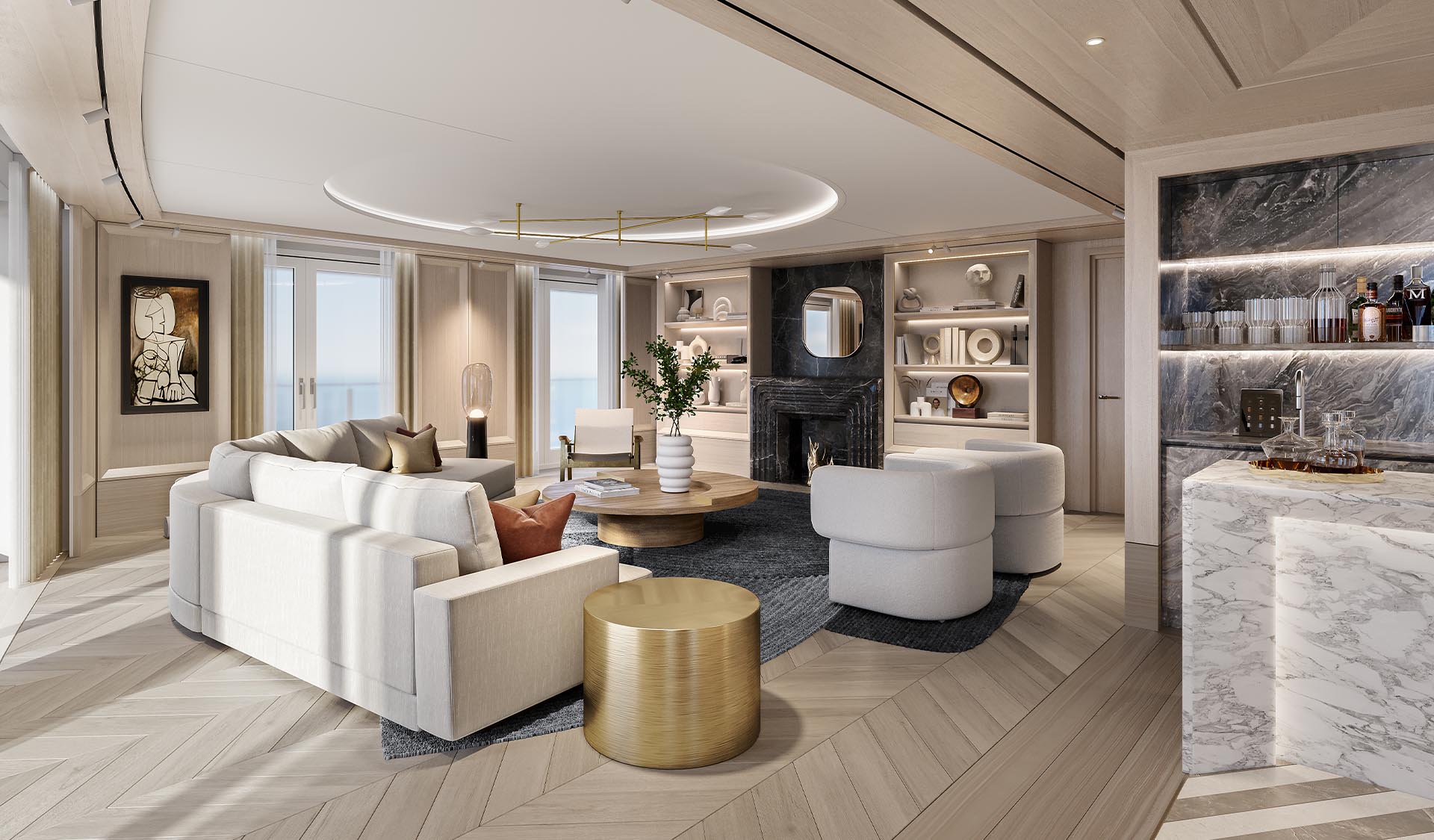
A one-of-a-kind achievement in lavish accommodations, this unparalleled suite boasts an in-suite spa retreat, private balcony with a Tresse Minipool, two magnificent bedrooms and more. Simply astonishing luxury.
Suite Size | 3150 sq. ft
Balcony Size | 1291 sq. ft
AMENITIES
-
INCLUDED: Business Class Air
- INCLUDED: 1-Night Pre-Cruise Hotel Package Including: INCLUDED Transfer Between Hotel and Ship, INCLUDED Breakfast & INCLUDED Porterage
- INCLUDED: Personal Car and Guide to Explore Ashore
- INCLUDED & UNLIMITED In-Suite Spa Services
- INCLUDED: Laundry and Dry Cleaning
- Exclusive Access to The Study, A Private Dining Room For Up To 12 Guests
- Personal Butler
- Guaranteed Reservation Each Night in Specialty Restaurant of Your Choice†
- Luxurious Bath Amenities
- Preferred Selection of Luxurious Bed Linens and Pillow Menu
- Selection of Aromatic Suite Fragrances
- Daily Canapés
- Personalized In-Suite Full-Liquor Bar Set-Up
- Priority Check-in on embarkation day with suite access at Noon
- Interactive Flat-Screen Television and Direct-Dial Satellite Phone
- Vanity and Hair Dryer
- Regent Plush Bathrobes and Slippers
- Priority Online Shore Excursions and Dining Reservations
- 10% Discount on Premium Wine and Liquor
- L’Occitane® Mer & Mistral Soaps, Shampoos and Lotions
- 1 Sumptuous In-Suite Caviar Service
- Direct Dial Satellite Phone
- Shoe Shine Service
- Personalized Stationery
- Delivery of Up to Three Daily Newspapers
LAYOUT
-
Private Balcony – Among the Largest at Sea with custom-made Tresse Minipool
- 2 Spacious Bedrooms
- Spacious Living Room With Sitting Area
- Private In-suite Spa with Sauna, Steam Room and Jetted Tub
- 3 Walk-in Closets, 2 Safes
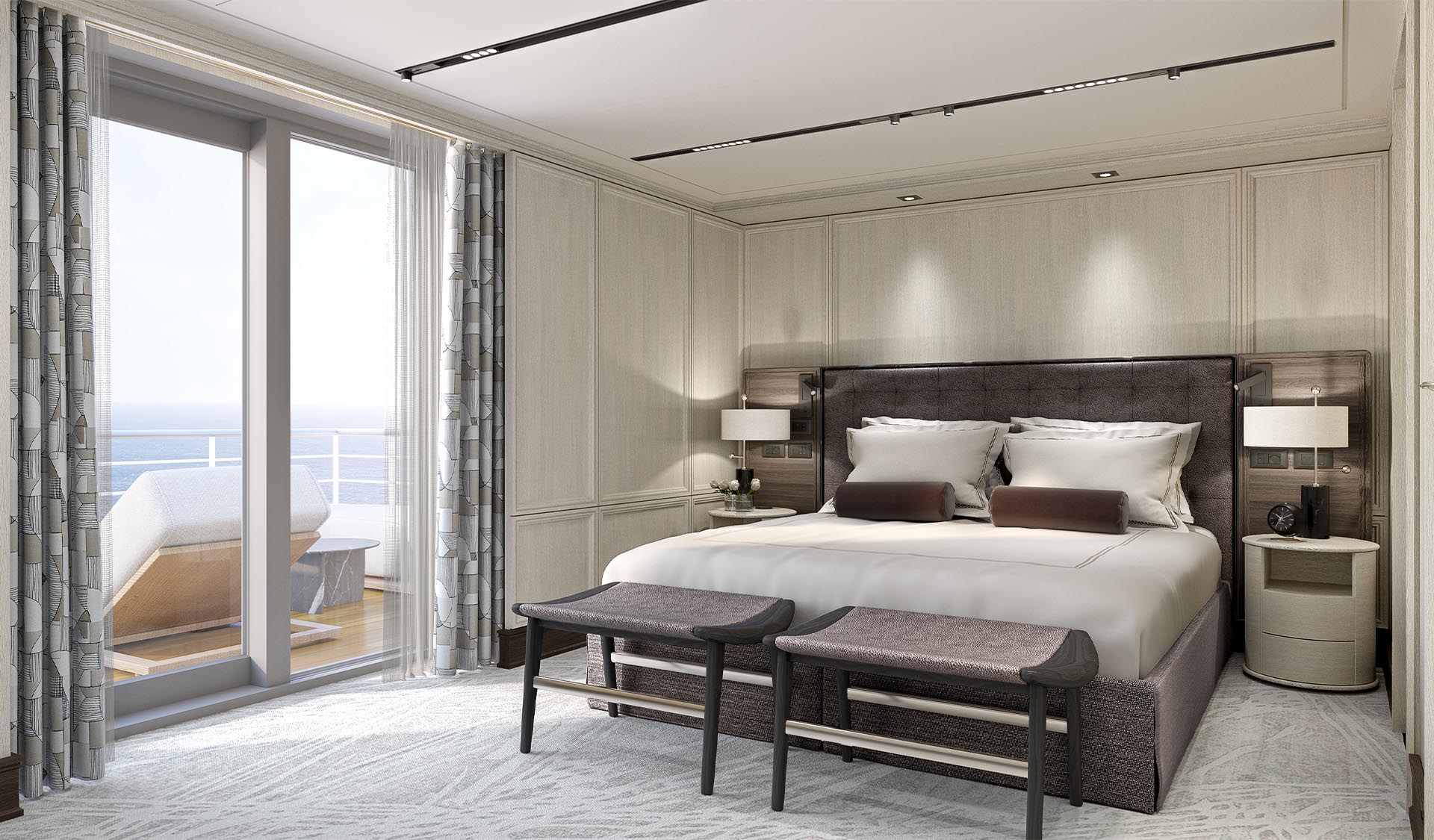
A rich colour palette, the finest fabrics and a grand piano create sophisticated comfort and a true urban chic. Plenty of space, including a large living room and a wrap-around private balcony, makes entertaining a breeze.
Suite Size | 1064 – 1114 sq. ft
Balcony Size | 831 – 994 sq. ft
AMENITIES
- FREE 1-Night Pre-Cruise Hotel Package Including: FREE Ground Transfers, FREE Breakfast & FREE Porterage
- INCLUDED & UNLIMITED WiFi includes up to four logins, four devices, per suite
- FREE Valet Laundry Service
- Personal Butler
- Welcome Bottle of Premium Champagne
- 1 Sumptuous In-Suite Caviar Service
- Guaranteed Reservation Each Night in Specialty Restaurant of Your Choice†
- Personalized In-Suite Full-Liquor Bar Set-Up
- Luxurious Bath Amenities
- Interactive Flat-Screen Television and Direct-Dial Satellite Phone
- Vanity and Hair Dryer
- Regent Plush Bathrobes and Slippers
- Daily Canapés
- Personalized In-Suite Mini-Bar Set-Up
- Priority Check-in on embarkation day with suite access at Noon
- Priority Online Shore Excursions and Dining Reservations
- 10% Discount on Premium Wine and Liquor
- 5% savings on Pre- or Post-Cruise Hotel or Land Programs
- 5% savings on Regent Choice Shore Excursions
LAYOUT
- Private Balcony – Among the Largest at Sea
- 2 Spacious Bedrooms with European King-Sized Elite Slumber™ Bed
- Spacious Living Room With Sitting Area
- 2 Marble and Stone Detailed Bathrooms
- Walk-in Closet With Safe
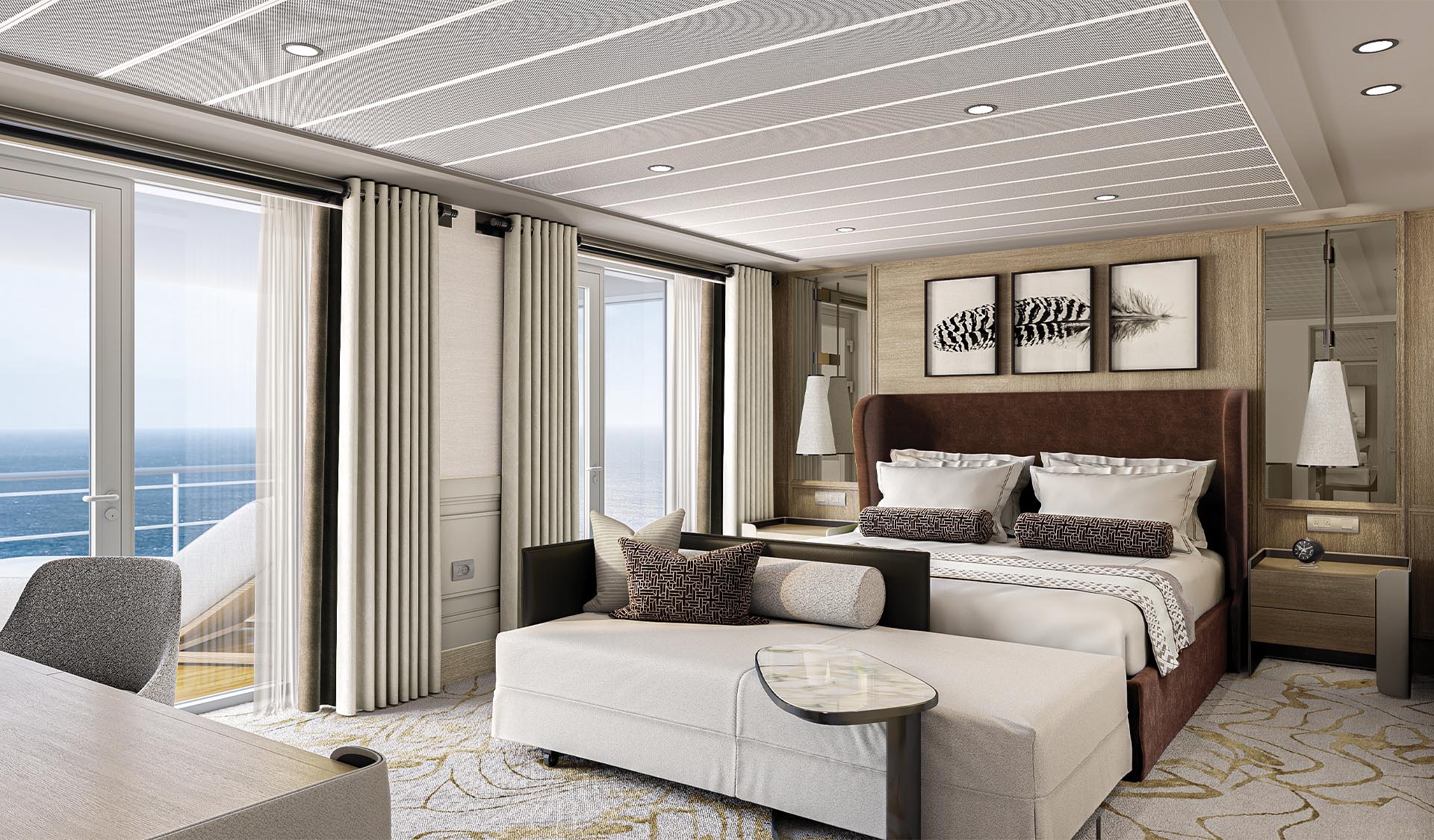
Experience the joy of sailing the world with an exquisitely designed space like this suite to call home throughout your voyage. Indulge in a sumptuous living room, two full baths, lavish bath products and a private balcony.
Suite Size | 853 – 1012 sq. ft
Balcony Size | 277 – 916 sq. ft
AMENITIES
- FREE 1-Night Pre-Cruise Hotel Package Including: FREE Ground Transfers, FREE Breakfast & FREE Porterage
- INCLUDED & UNLIMITED WiFi includes up to four logins, four devices, per suite
- FREE Valet Laundry Service
- Personal Butler
- Luxurious Bath Amenities
- Interactive Flat-Screen Television and Direct-Dial Satellite Phone
- Vanity and Hair Dryer
- Welcome Bottle of Premium Champagne
- Regent Plush Bathrobes and Slippers
- Daily Canapés
- Personalized In-Suite Mini-Bar Set-Up
- Priority Check-in on embarkation day with suite access at Noon
- 1 Sumptuous In-Suite Caviar Service
- Guaranteed Reservation Each Night in Specialty Restaurant of Your Choice†
- Priority Online Shore Excursions and Dining Reservations
- 10% Discount on Premium Wine and Liquor
- 5% savings on Pre- or Post-Cruise Hotel or Land Programs
- 5% savings on Regent Choice Shore Excursions
LAYOUT
- Private Balcony – Among the Largest at Sea
- 1 Spacious Bedroom with European King-Sized Elite Slumber™ Bed
- Spacious Living Room With Sitting Area
- 2 Marble and Stone Detailed Bathrooms
- Walk-in Closet With Safe

A glamorous home away from home with a private balcony that’s among the largest at sea. Luxuriate in its spacious living room and sitting area, and impress guests with a full-liquor bar and in-suite caviar service.
Suite Size | 655 sq. ft
Balcony Size | 165 – 263 sq. ft
AMENITIES
-
FREE Valet Laundry Service
- FREE 1-Night Pre-Cruise Hotel Package Including: FREE Ground Transfers, FREE Breakfast & FREE Porterage
- INCLUDED & UNLIMITED WiFi includes up to four logins, four devices, per suite
- Personal Butler
- Welcome Bottle of Premium Champagne
- Luxurious Bath Amenities
- Interactive Flat-Screen Television and Direct-Dial Satellite Phone
- Priority boarding on Embarkation Day with Suite Access at 1:00 pm
- Welcome Letter from President and General Manager
- Personalized In-Suite Full-Liquor Bar Set-Up
- 1 Sumptuous In-Suite Caviar Service
- 10% Discount on Premium Wine and Liquor
- 5% savings on Pre- or Post-Cruise Hotel or Land Programs
- 5% savings on Regent Choice Shore Excursions
- Regent Plush Bathrobes and Slippers
- Daily Canapés
- Priority Online Shore Excursions and Dining Reservations
- Delivery of Up to Three Daily Newspapers
- Bath Scale
- Vanity and Hair Dryer
LAYOUT
-
Private Balcony – Among the Largest at Sea
- 1 Spacious Bedroom with European King-Sized Elite Slumber™ Bed
- Spacious Living Room With Sitting Area
- 1 1/2 Marble and Stone Detailed Bathrooms
- Walk-in Closet With Safe
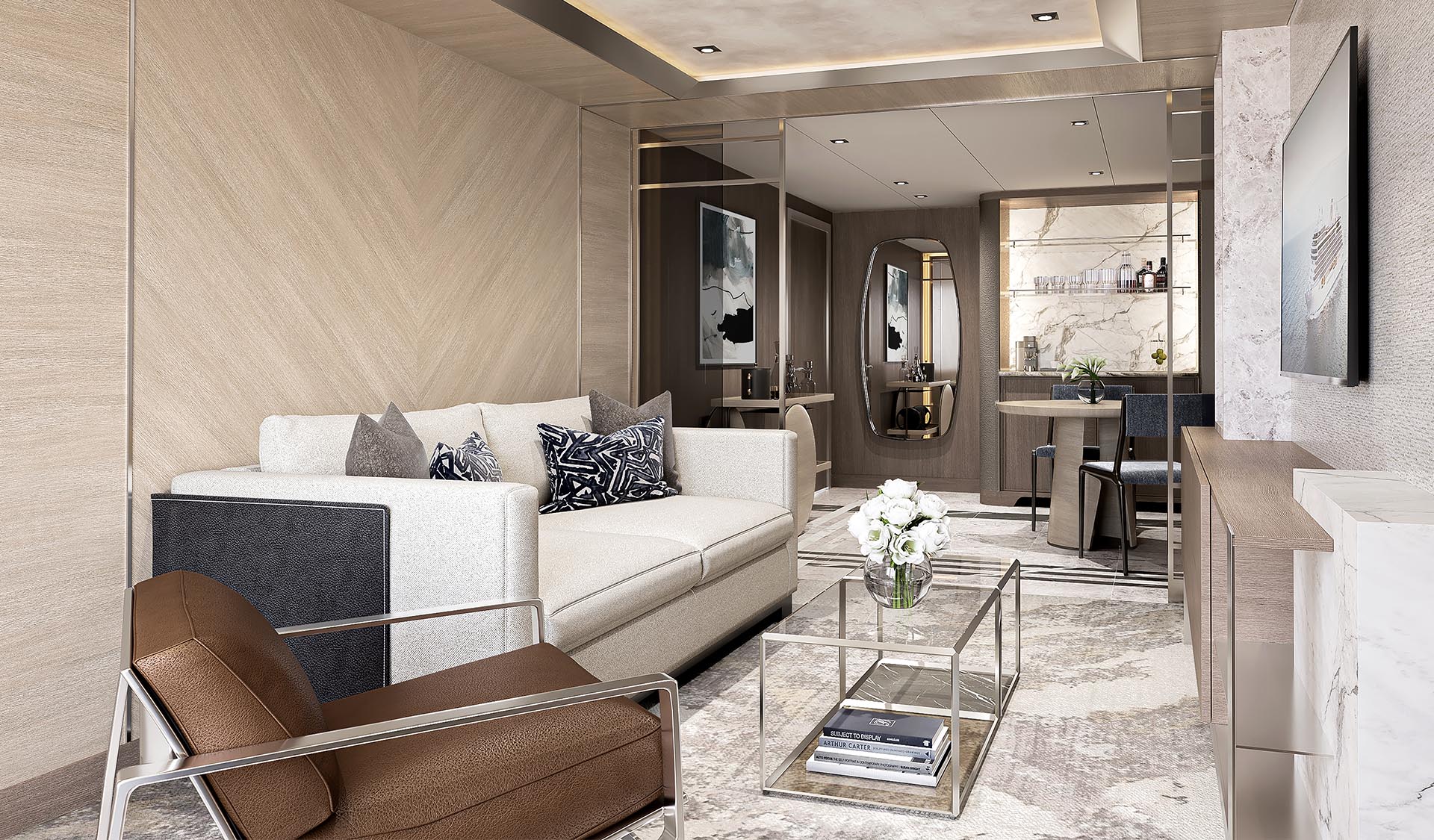
With glorious vistas in every direction, this suite is designed to complement the soothing nature of the world outside. Your private balcony will beckon from your stylish sitting area, as will the marble accents of your baths.
Suite Size | 577 sq. ft
Balcony Size | 237 sq. ft
AMENITIES
- FREE Valet Laundry Service
- FREE 1-Night Pre-Cruise Hotel Package Including: FREE Ground Transfers, FREE Breakfast & FREE Porterage
- INCLUDED & UNLIMITED WiFi includes up to four logins, four devices, per suite
- Personal Butler
- Luxurious Bath Amenities
- Interactive Flat-Screen Television and Direct-Dial Satellite Phone
- Vanity and Hair Dryer
- Regent Plush Bathrobes and Slippers
- Daily Canapés
- Personalized In-Suite Mini-Bar Set-Up
- Priority boarding on Embarkation Day with Suite Access at 1:00 pm
- Priority Online Shore Excursions and Dining Reservations
- 10% Discount on Premium Wine and Liquor
- 5% savings on Pre- or Post-Cruise Hotel or Land Programs
- 5% savings on Regent Choice Shore Excursions
LAYOUT
-
Private Balcony – Among the Largest at Sea
- 1 Spacious Bedroom with European King-Sized Elite Slumber™ Bed
- Spacious Living Room With Sitting Area
- 1 Marble and Stone Detailed Bathroom
- Walk-in Closet With Safe
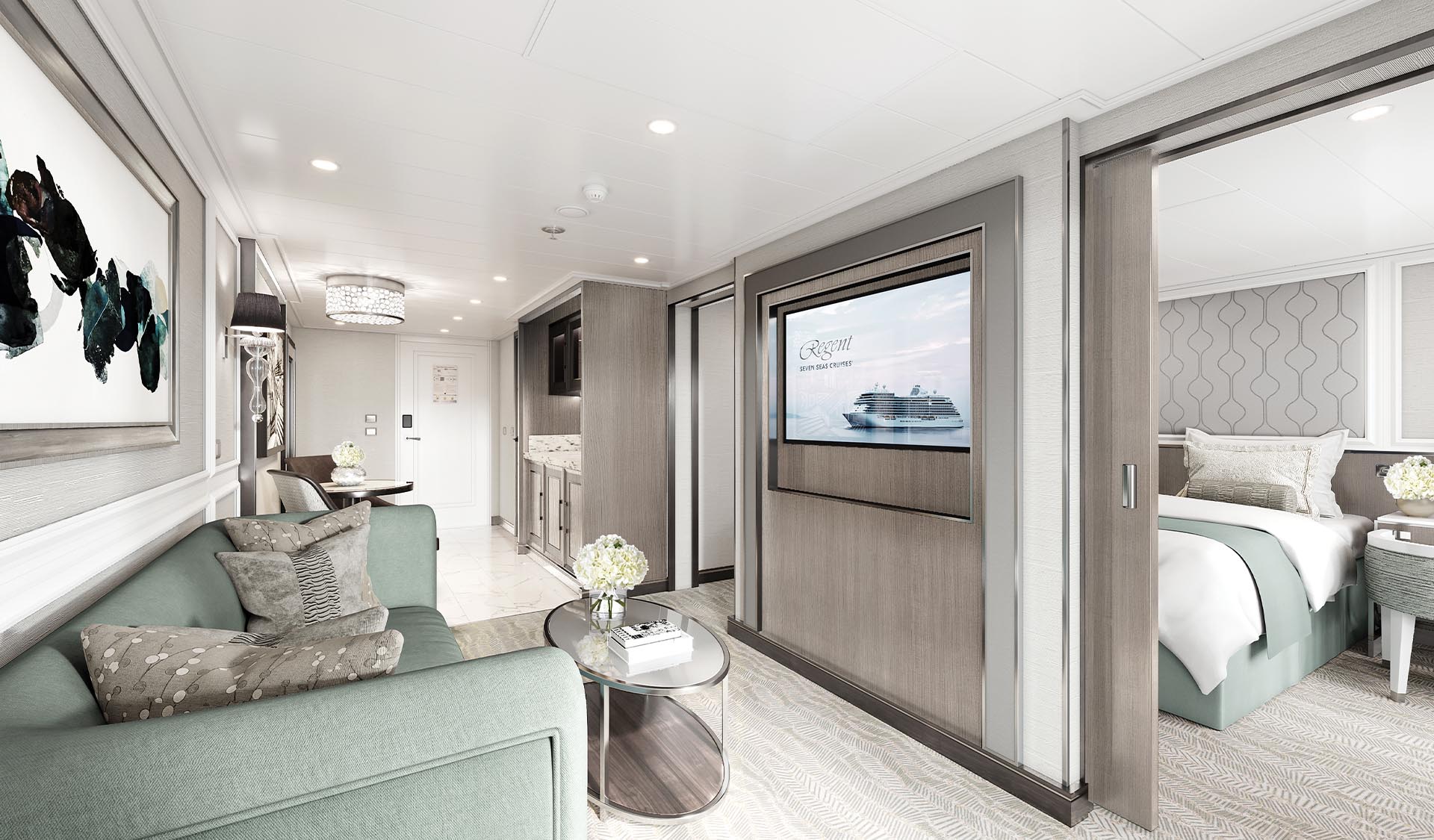
Designed to maximize your space and comfort — highlighted by a beautifully furnished sitting area and private balcony — you’ll relish time spent in this luxurious suite as you prepare for your next onshore adventure.
Suite Size | 450 sq. ft
Balcony Size | 111 – 193 sq. ft
AMENITIES
- FREE Valet Laundry Service
- FREE 1-Night Pre-Cruise Hotel Package Including: FREE Ground Transfers, FREE Breakfast & FREE Porterage
- INCLUDED & UNLIMITED WiFi includes up to four logins, four devices, per suite
- Personal Butler
- Luxurious Bath Amenities
- Interactive Flat-Screen Television and Direct-Dial Satellite Phone
- Vanity and Hair Dryer
- Regent Plush Bathrobes and Slippers
- Daily Canapés
- Personalized In-Suite Mini-Bar Set-Up
- Priority Online Shore Excursions and Dining Reservations
- 10% Discount on Premium Wine and Liquor
- 5% savings on Pre- or Post-Cruise Hotel or Land Programs
- 5% savings on Regent Choice Shore Excursions
LAYOUT
- Private Balcony – Among the Largest at Sea
- European King-Sized Elite Slumber™ Bed
- Spacious Living Room With Sitting Area
- 1 Marble and Stone Detailed Bathroom featuring a glass-enclosed shower instead of bathtub
- Walk-in Closet With Safe
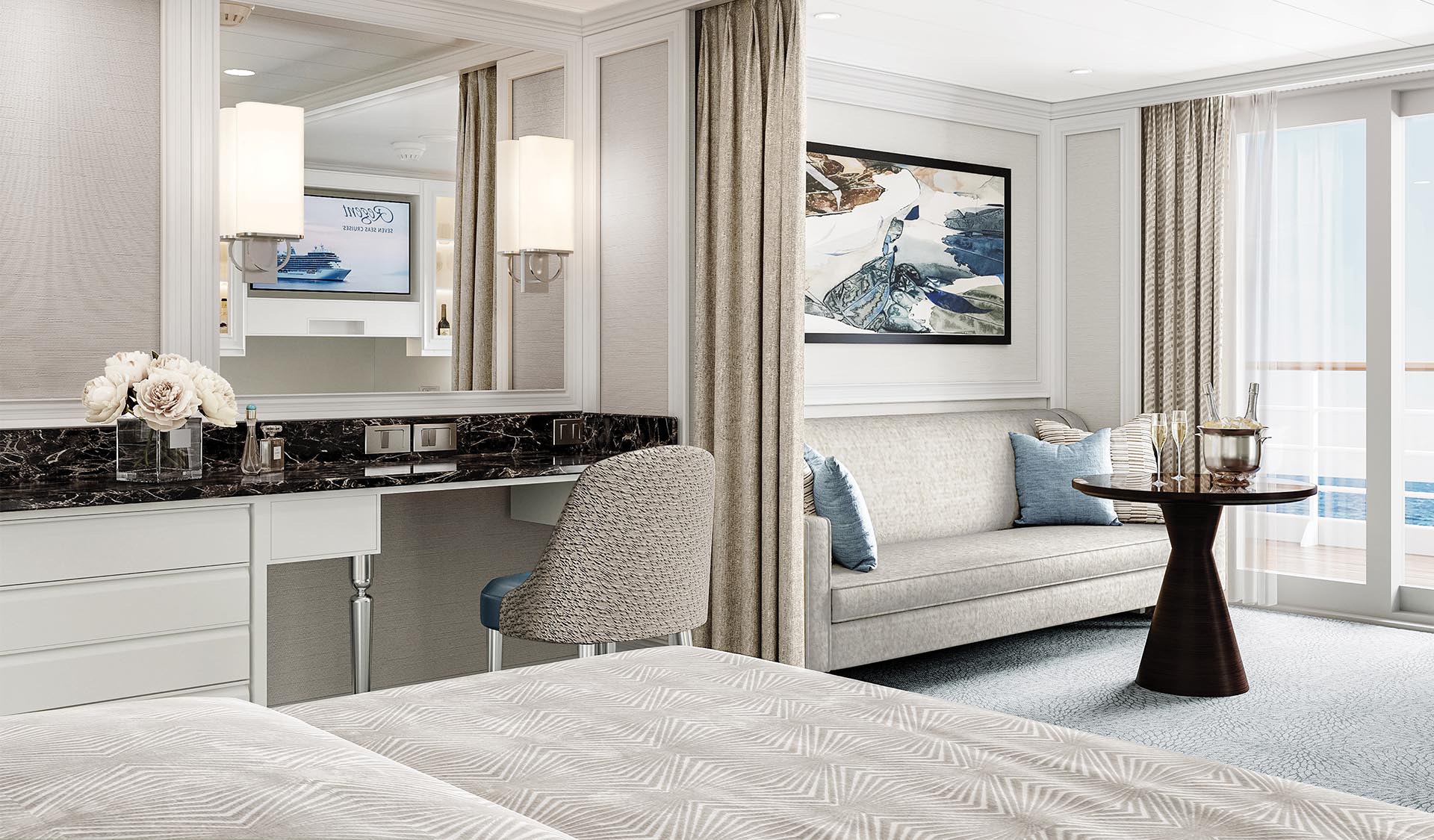
Step out onto your private balcony with a freshly made cup of coffee and take in the grandeur of ocean travel. This suite is packed with stylish comfort and includes a king-sized bed with a spectacular horizon view.
Suite Size | 332 sq. ft
Balcony Size | 82 – 132 sq. ft
AMENITIES
-
FREE Valet Laundry Service
- FREE 1-Night Pre-Cruise Hotel Package Including: FREE Ground Transfers, FREE Breakfast & FREE Porterage
- INCLUDED & UNLIMITED WiFi includes up to four logins, four devices, per suite
- Luxurious Bath Amenities
- Interactive Flat-Screen Television and Direct-Dial Satellite Phone
- Vanity and Hair Dryer
- Regent Plush Bathrobes and Slippers
- Personalized In-Suite Mini-Bar Set-Up
- Priority Online Shore Excursions and Dining Reservations
- 10% Discount on Premium Wine and Liquor
- 5% savings on Pre- or Post-Cruise Hotel or Land Programs
- 5% savings on Regent Choice Shore Excursions
LAYOUT
- Private Balcony – Among the Largest at Sea
- European King-Sized Elite Slumber™ Bed
- Spacious Living Room With Sitting Area
- Marble and Stone Detailed Bathroom
- Walk-in Closet With Safe
This category includes Accessibility Options in suites 822 and 823. For more information about accessible suites click here.

Sometimes, a bit of extra space goes a long way. With a stylish living area that includes a sitting area, walk-in closet and dual sinks in the bathroom, you’ll have more room to unwind after your daily adventures.
Suite Size | 331 sq. ft
Balcony Size | 83 – 132 sq. ft
AMENITIES
- FREE Valet Laundry Service
- FREE Unlimited WiFi includes one log-in, one device, per suite*
- Luxurious Bath Amenities
- Interactive Flat-Screen Television and Direct-Dial Satellite Phone
- Vanity and Hair Dryer
- Regent Plush Bathrobes and Slippers
- Personalized In-Suite Mini-Bar Set-Up
LAYOUT
- Private Balcony
- European King-Sized Elite Slumber™ Bed
- Spacious Living Room With Sitting Area
- 1 Marble and Stone Detailed Bathroom
- Walk-in Closet With Safe

First, the view — soak in the entirety of your ocean-going adventure out on your private balcony, or get cozy in your floor-to-ceiling-windowed sitting area. Inside is perfectly designed for maximum elegance and comfort.
Suite Size | 252 sq. ft
Balcony Size | 54 – 107 sq. ft
AMENITIES
- FREE Valet Laundry Service
- FREE Unlimited WiFi includes one log-in, one device, per suite*
- Luxurious Bath Amenities
- Interactive Flat-Screen Television and Direct-Dial Satellite Phone
- Vanity and Hair Dryer
- Regent Plush Bathrobes and Slippers
- Personalised In-Suite Mini-Bar Set-Up
LAYOUT
- Private Balcony
- European Queen Size Elite Slumber™ Bed
- Spacious Living Room With Sitting Area
- 1 Marble and Stone Detailed Bathroom featuring a glass-enclosed shower instead of bathtub
- Built-in Closet With Safe
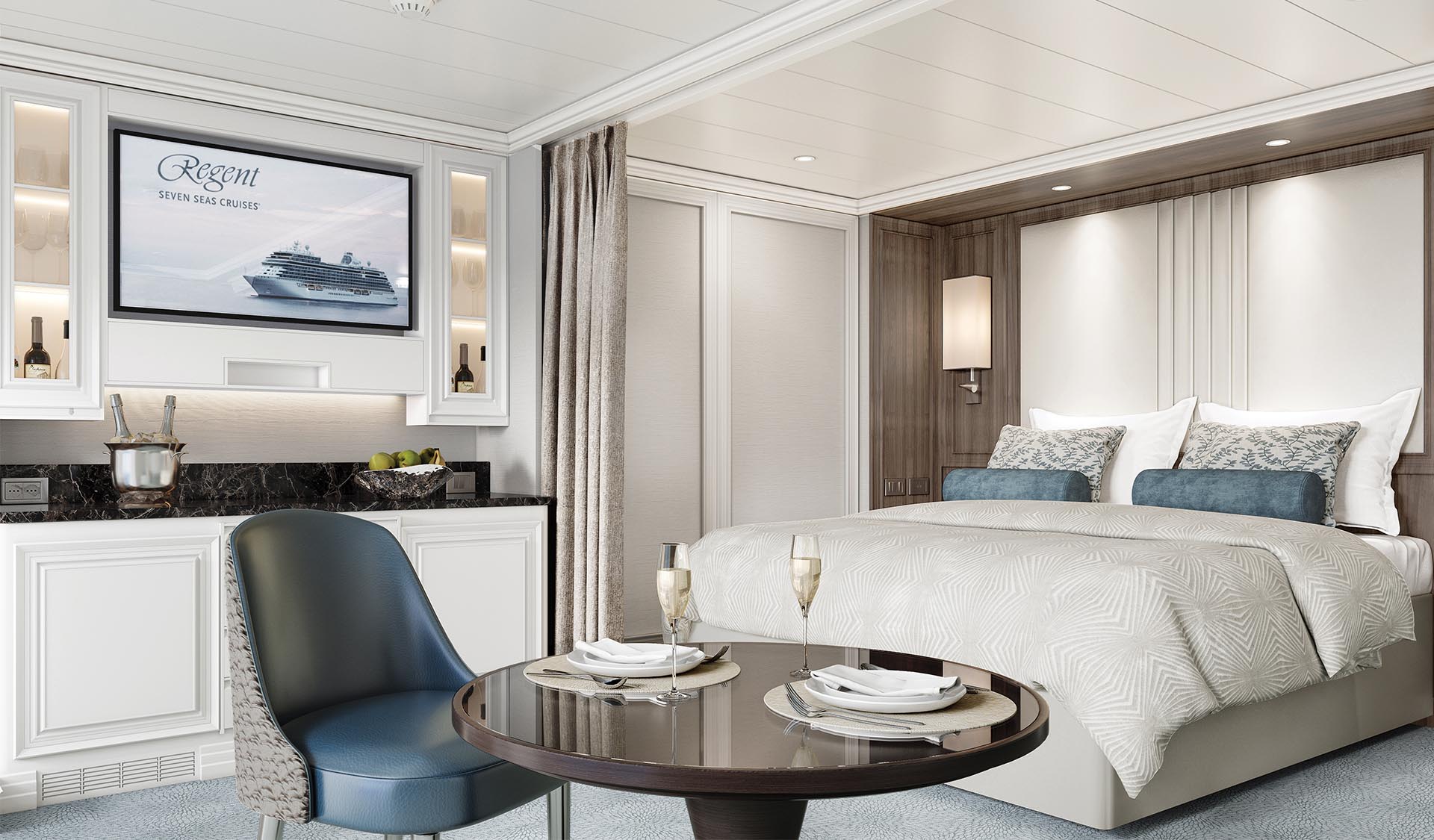
A private balcony to sip the beverage of your choice, a sitting area with a table for in-suite breakfasts, lavish bath products, a flat-screen TV… this suite has all you need to feel spoiled on an unforgettable voyage.
Suite Size | 220 sq. ft
Balcony Size | 88 sq. ft
AMENITIES
- FREE Valet Laundry Service
- FREE Unlimited WiFi includes one log-in, one device, per suite*
- Luxurious Bath Amenities
- Interactive Flat-Screen Television and Direct-Dial Satellite Phone
- Vanity and Hair Dryer
- Regent Plush Bathrobes and Slippers
- Personalized In-Suite Mini-Bar Set-Up
LAYOUT
- Private Balcony
- European Queen Size Elite Slumber™ Bed
- Spacious Living Room With Sitting Area
- 1 Marble and Stone Detailed Bathroom featuring a glass-enclosed shower instead of bathtub
- Built-in Closet With Safe
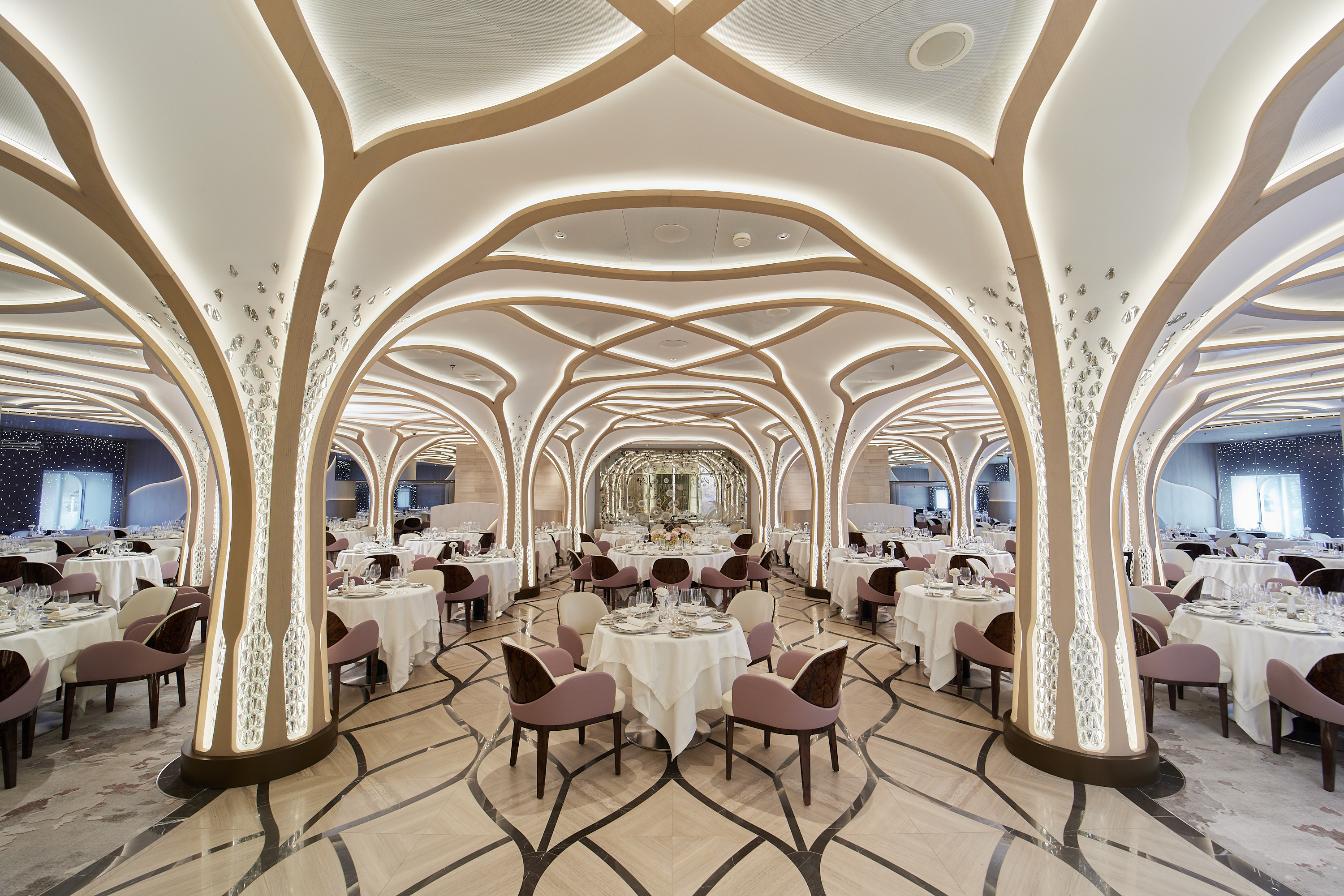
Our largest specialty restaurant on a ship full of spectacular dining options. Design your very own entrée from preferred sides, sauces, pastas and main features of beef, poultry and fish. Dessert? Decadent, of course.
We are pleased to re-introduce the elegantly enhanced Compass Rose, the largest specialty restaurant across our fleet. Ensuring a tantalising mix of new and familiar items on every visit, the new lunch and dinner menus offer a vast selection to meet your discerning tastes. Exclusively aboard Seven Seas Mariner®, Seven Seas Voyager®, and Seven Seas Navigator® for lunch, you may choose from a robust list of appetisers and main courses from our specialty restaurants. And across our fleet for dinner, you have the unique ability to design your very own entrée from preferred sides, sauces, pastas and main features of beef, poultry and fish. This is in addition to sinfully indulgent desserts made by talented bakers and pastry chefs. With daily changing menus, the refreshed Compass Rose offers more choices than ever before.
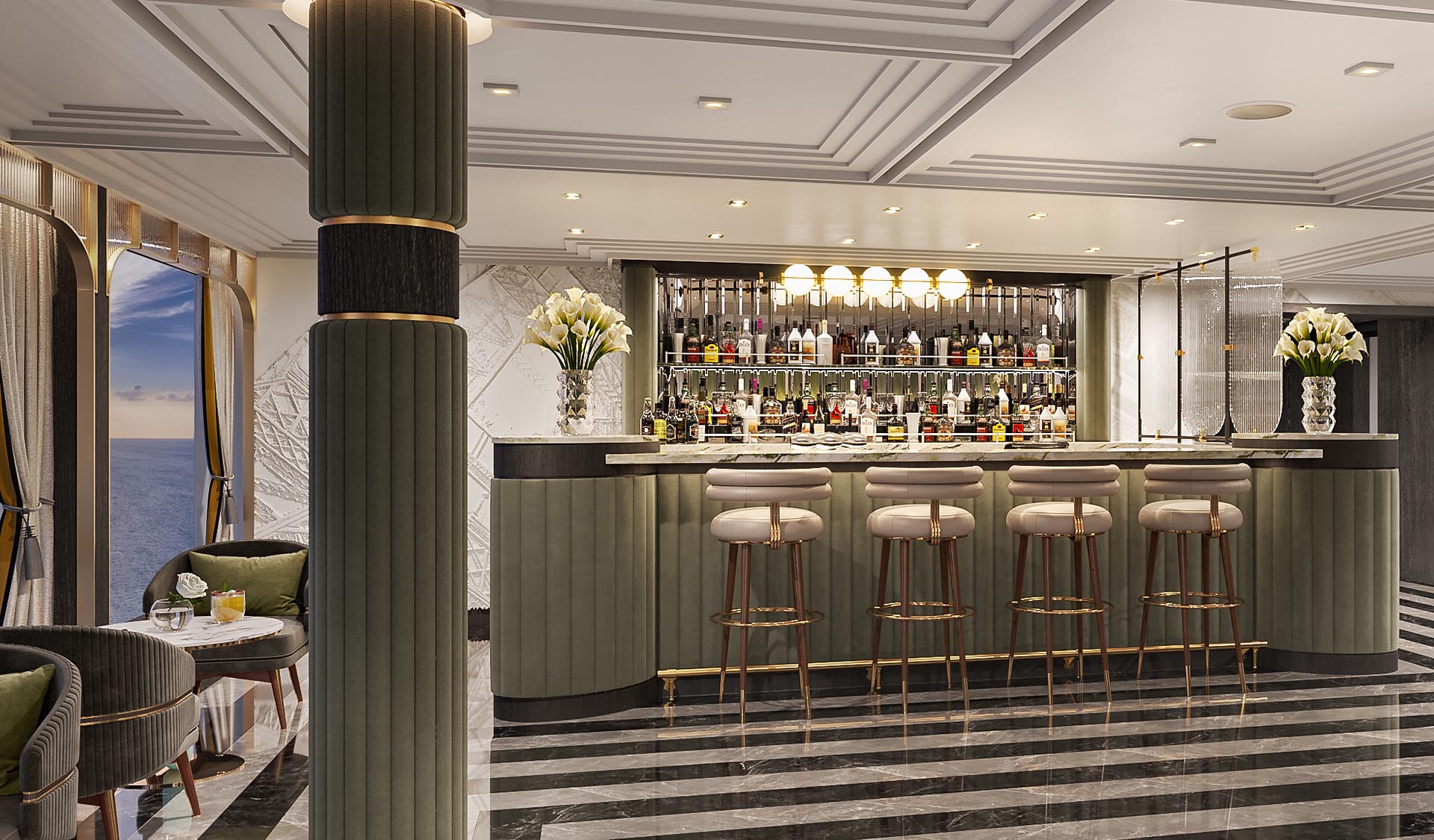
Classic French fare with a modern twist – and glorious ocean views. If Chartreuse seems familiar, you may have once stumbled upon a chic, fine-dining restaurant on a Champs-Elysees side street. A fantasy you can taste.
Chartreuse evokes memories of a chic Parisian fine dining restaurant discovered during an evening stroll. Wherever you are seated in this regal restaurant, you will be treated to a succulent dinner while enjoying incredible ocean views. The restaurant ambiance is complemented by a menu that features modern French dishes. Available on Seven Seas Grandeur™, Seven Seas Splendor®, Seven Seas Explorer®, Seven Seas Mariner® and Seven Seas Voyager® with reservations each evening for dinner, and open for lunch on Seven Seas Explorer on alternate port days. French bistro style food is offered.
Reservations Required
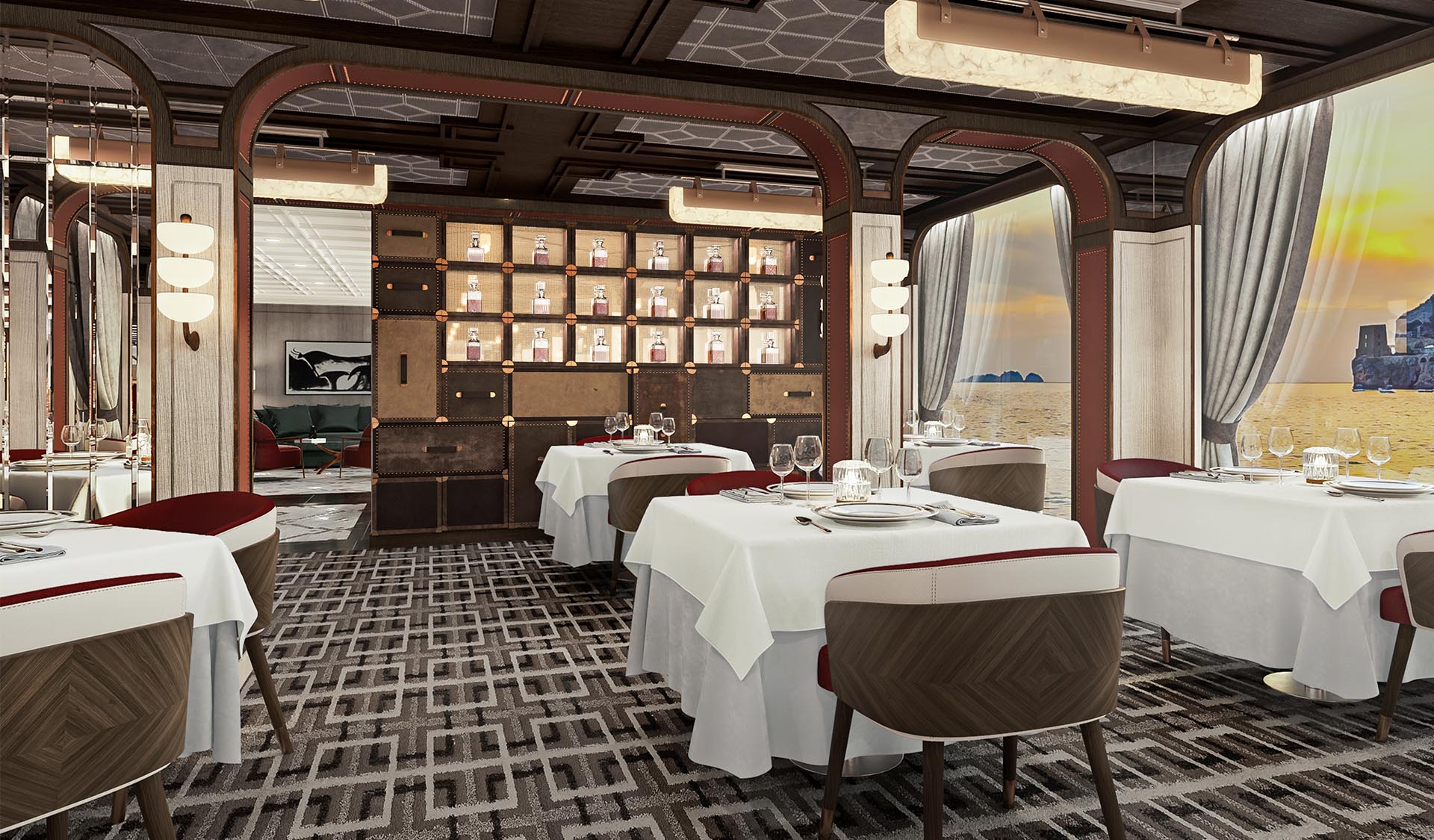
From perfectly aged prime New York strip, porterhouse and succulent filet mignon to smoked salmon with a phenomenal tamarind-whiskey sauce, Prime 7 elevates classic American fare to lofty heights.
A true classic in every sense, Prime 7 sets a new standard in steakhouse fare with its contemporary interpretation of an American classic. Handsomely decorated with supple leather wing-back chairs, burnished woods and rich earth-toned fabrics, Prime 7 exudes a distinct, intimate elegance. This is sophistication redefined, a luxurious setting to enjoy classic steakhouse cuisine with a modern flair.
All the traditional starters are here, including Jumbo Lump Crab Cakes, Classic Steak Tartare, and Clam Chowder. Of course, beef is the undisputed star, and it is all USDA Prime and Dry-Aged at least 28 days to ensure the ultimate tenderness and juiciness. Prime New York Strip, Porterhouse Steak and succulent Filet Mignon only touch upon the selections. Mouthwatering alternatives include Applewood Smoked Salmon and Dover Sole.
Reservations Required

Prepare to be delighted by a perfect balance of delicious flavours and Zen-like ambiance. Amid dimly lit architectural details and lotus-shaped windows, dine Pan-Asian creations like Korean barbecue lamb chops and wok-fried beans.
Celebrating the culinary traditions of Asia, our new Pan-Asian specialty restaurant, Pacific Rim delights guests with the perfect balance of delicious flavours and Zen-like ambiance. The interior glows with muted lighting that illuminates intricate architectural details. During dinner, guests are treated to incredible ocean views through windows designed in an abstract lotus shape, a universal Asian motif. To complement the stunning décor, Pacific Rim’s chefs created a delectable menu of Pan-Asian creations with dishes such as grilled Korean barbecue lamb chops, wok-fried beans, eryngii mushroom and gochujang dressing. Available on Seven Seas Splendor® and Seven Seas Explorer®, and Seven Seas Grandeur™.
Reservations Required

So much more than a great spot for coffee – this specially designed Coffee Connection is a chic metropolitan café with an ocean view that’s impossible to beat.

Settle into cosy, over-water alcoves for classic Italian specialties made with care. From old-school classics to modern cuisine, your Sette Mari meal will linger long as a perfect combination of atmosphere and flavour.
Each evening, La Veranda transforms into Sette Mari at La Veranda, a casual, intimate dining experience. Enjoy an extensive menu of authentic antipasti and Italian classis served á la carte and paired with fine Italian wines — complimentary of course. Delectable dishes are prepared á la minute by our talented chefs using only the freshest gourmet ingredients and served by our attentive waiters. Sette Mari at La Veranda is open for dinner only.
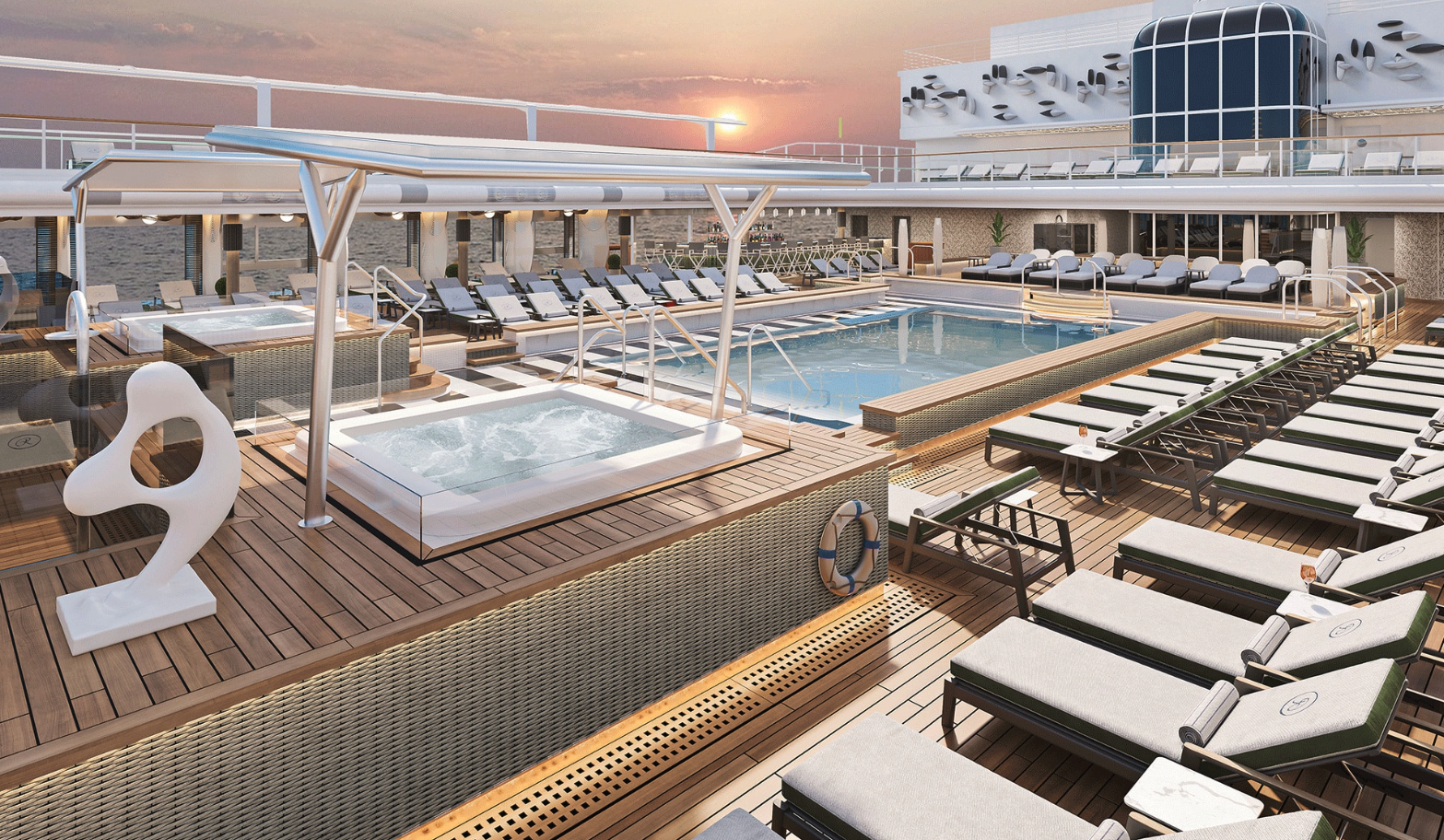
Al fresco dining with views of the world’s best-loved landscapes. Be inspired by the environs around Seven Seas Grandeur™ while enjoying lunch and casual dinners that include regional barbecues and old-fashioned desserts.
The Pool Grill is truly a come-as-you-are dining venue. Enjoy this casual dining experience whether you’re getting a bite after sunbathing or swimming in the pool. Come by before or after a shore excursion – or enjoy a snack between activities. The Pool Grill is open-air, yet abundantly shaded for comfortable dining. Enjoy grilled-to-order burgers, grilled seafood, sandwiches, and fresh salads. Treat yourself to milkshakes and malts or an old-fashioned hand-dipped ice cream dessert sprinkled with all your favourite toppings.

Greet your days on the high seas with sumptuous breakfasts and shimmering ocean views. La Veranda features quiet alcoves, made-to-order omelettes and, for late risers, tasty lunch buffets that include hot carving stations.
Take in stunning ocean views while enjoying elegant breakfast and lunch buffets in the chic indoor dining room or al fresco on the shaded, open-air deck. Breakfasts include traditional favourites, as well as a made-to-order omelet station, a variety of fresh fruits and pastries, along with daily specials, like fluffy Belgian waffles with fresh blueberry compote. For lunch indulge in an array of choices from a bountiful salad bar, gourmet sandwiches, hot carving stations and delicious desserts.
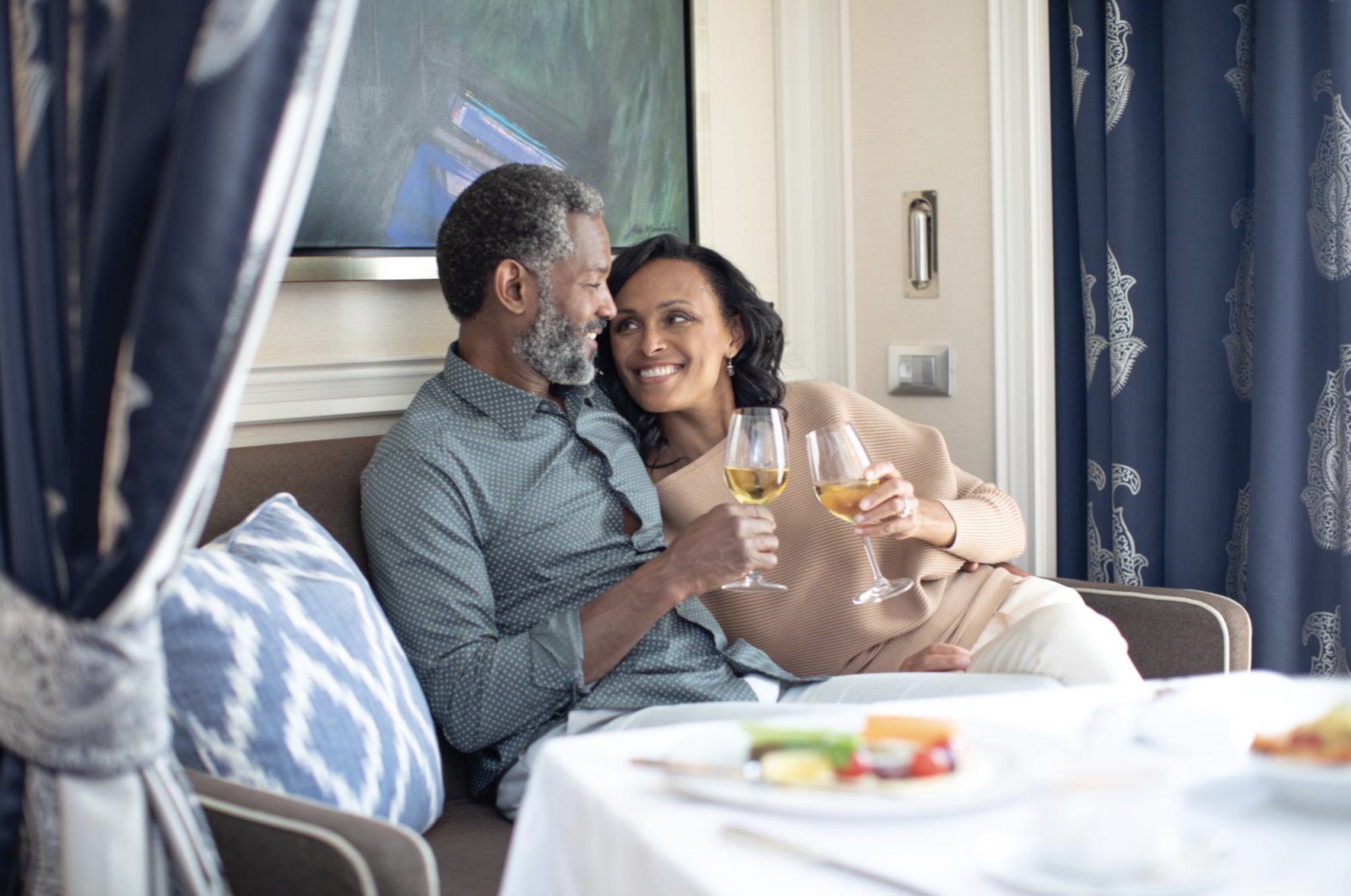
Enjoy delectable appetisers, main courses and desserts in your suite 24 hours a day. During dinner hours, delight in ordering dishes made to your exact taste from the expansive Compass Rose menu.
Knowing that guests sometimes prefer to simply dine in the comfort of their suites, we offer room service around the clock. Select from an extensive room service menu and the wait staff will promptly serve your order in the comfort of your suite. During normal dining hours, guests may also order from the Compass Rose menu, which changes daily and features Continental, vegetarian, and kosher cuisines. Dinners will be graciously served course-by-course.

Guests of the most luxurious suite on the high seas — the Regent Suite on Seven Seas Grandeur™ — have exclusive access to The Study, a private, ornately decorated dining room that seats up to 12 guests.
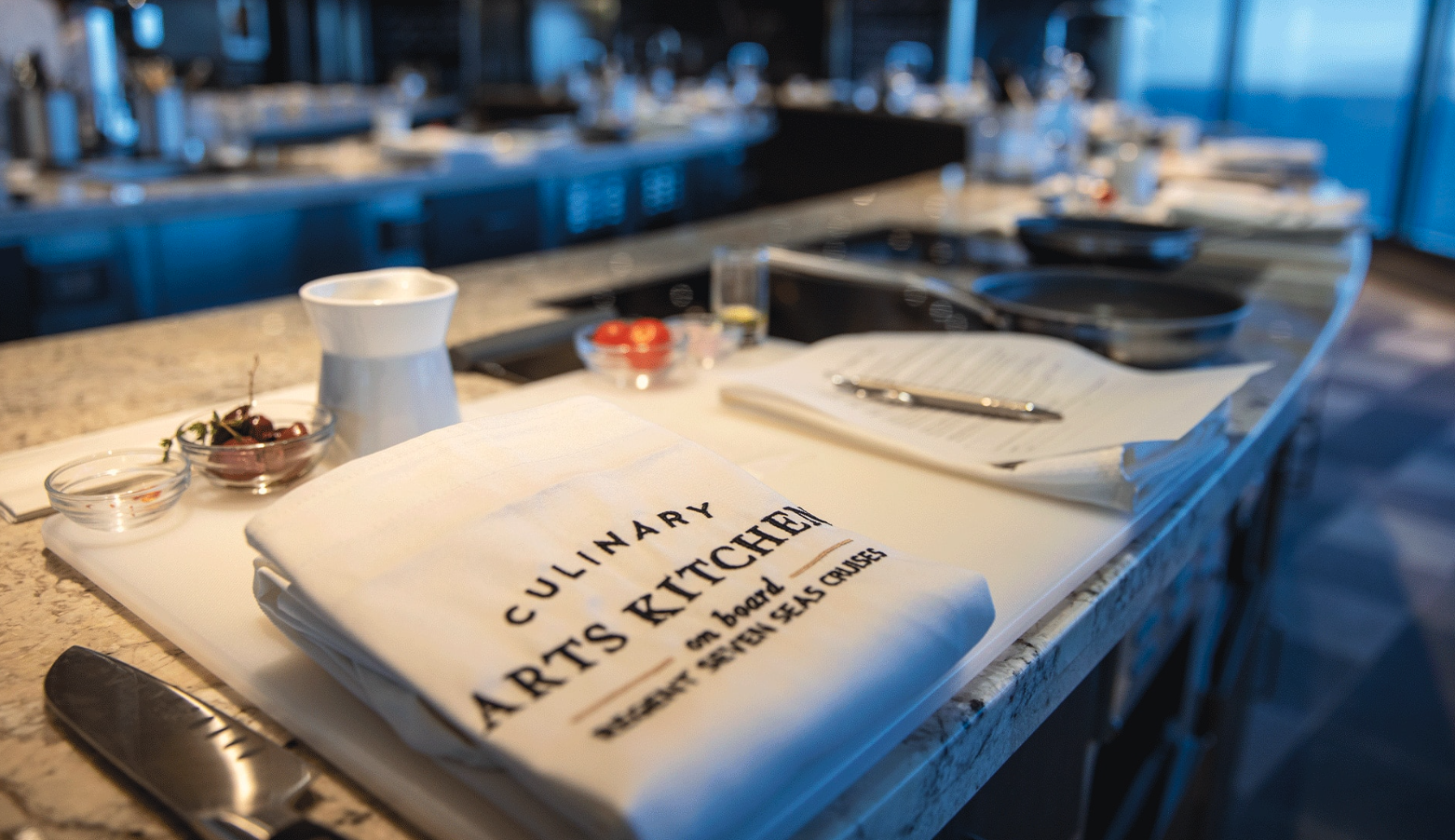
We spared no expense to bring you an authentic cooking school experience. Our Culinary Arts Kitchen features 18 cooking stations with quartzite countertops and stainless steel accents. The rest is up to you!

Embrace amazing opportunities in each port of call with more than 3,800 Included & Unlimited Shore Excursions across every region of the world. Indulge in any variety of interests, from the history and ancestry found at hundreds of UNESCO World Heritage Sites to the beauty and culture of present-day people experienced through their food, music and art.
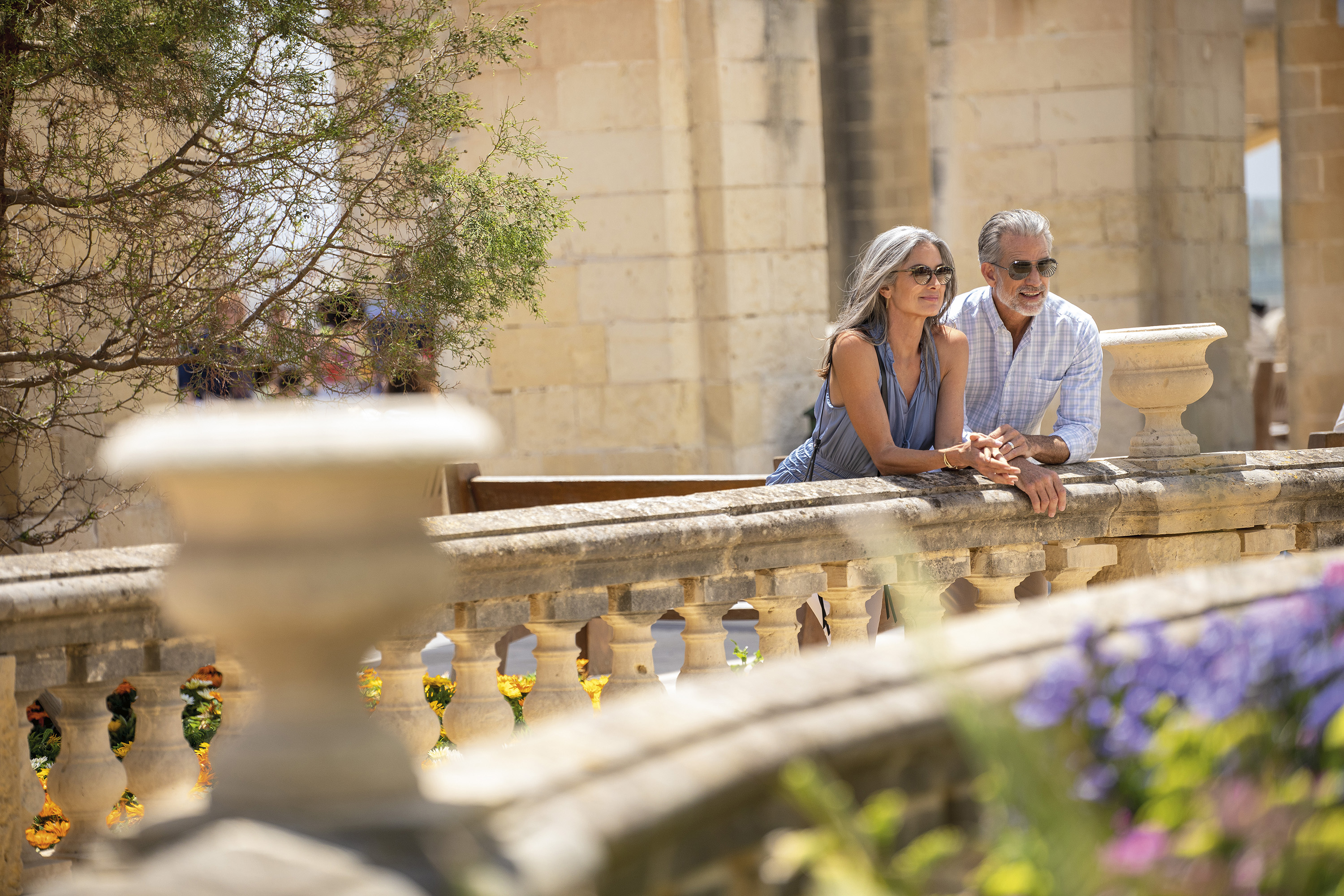
Taste the cultures of the world with our specially curated, Master Chef-led, Gourmet Explorer Tours, unique to sailings aboard Seven Seas Splendor® and Seven Seas Explorer®. Be treated to a particularly French dining experience with Michelin-starred Master Chef René Bérard at his private estate along with a Provençal cooking demonstration in Provence or be led through the open-air, seaside market in Nice and partake in an exquisite lunch at Château Eza in Eze. Please your palate and expand your culinary knowledge with each of our delectable Gourmet Explorer Tours.

As the name suggests, these excursions work a little harder to engage your explorer spirit. Unique itineraries and smaller groups create more personal experiences… and memories of a lifetime.
Unique, unparalleled experiences
Soaring over Alaskan forests and mountains via helicopter en route to feeling the majesty of Mendenhall Glacier beneath your feet. Discover the best our world has to offer through the unparalleled experiences you’ll enjoy with Regent Choice Shore Excursions.
Enhance your shoreside experience with a Regent Choice Small Group tour. Hosting up to 16 guests, these tours provide a more intimate experience and allow for more personal engagement with your knowledgeable guide.

Engage with local groups and businesses to learn about how they are transforming the world around them while experiencing the impact of their efforts first-hand.
Our Eco-Connect Tours provide enriching opportunities to interact with and learn from local communities around the world as they work to conserve and sustain their surrounding environments.
Discover the valuable and beautiful flora and fauna of places like Costa Rica, Vietnam and Australia. Sample the products of sustainable farming practices in regions like France, New Zealand and Argentina. Absorb the inspiring innovations in energy production at facilities in Portugal, Iceland and Japan. This is only a sampling of the more than 150 unique Eco-Connect Tours we offer.
Reinvigorate your love for the world around you with these insightful experiences — many of which are available as part of our FREE Unlimited Shore Excursions.

Glimpse behind the scenes of some of the most captivating and brilliant designs around the world.
Brilliant architectural achievements
Glimpse behind the scenes of some of the most captivating and brilliant designs around the world.
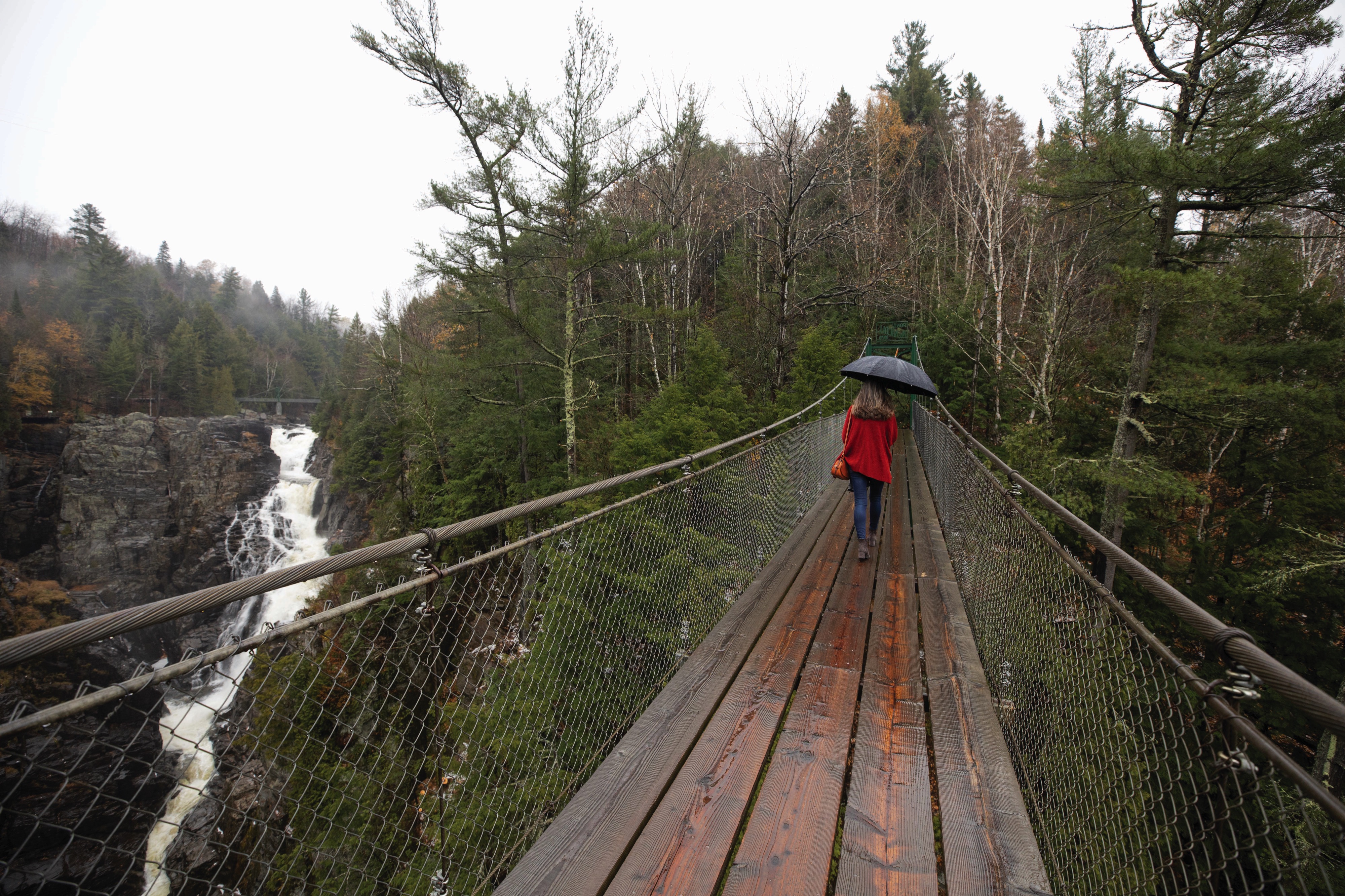
Go Local Tours provide a more direct way for you to experience the culture of a destination through the communities within. Spend a day at a family-owned goat farm in the countryside of Andalusia to learn the generations-old way of making cheese, discover the joy of fishing with the residents of Portofino or observe skilled local artists in their personal studios on Palma de Mallorca. Many Go Local tours are part of our FREE Unlimited Shore Excursions, while some require a discounted, supplementary charge. Experience the world through the eyes of those who actually live there and discover the best of what you didn’t know about your favorite destination with Go Local Tours.

Transcend the moment as you expand your mind and strengthen your body with a Wellness Tour. Soak in a restorative, mineral-rich thermal spring in Rome or center your chi with a taiji (tai chi) class on a beautiful and serene beach on Palma de Mallorca. Be refreshed by a Mediterranean breeze as you calm your mind and strengthen your focus through a yoga class overlooking the seaside town of Taormina. Restore and heal your mind, body and soul as you travel throughout the world with our Wellness Tours.

Evenings provide a different view of a city as the streets light up and the locals unwind. Discover the fun of a destination’s nightlife and enjoy more time ashore with more overnights in ports across every region of the world.

As indicated by its name, this feast for the eyes is a wonderful vantage point to enjoy staggering views as Seven Seas Grandeur® enters and leaves ports of call. A whimsical chandelier and live music add to the serenity.
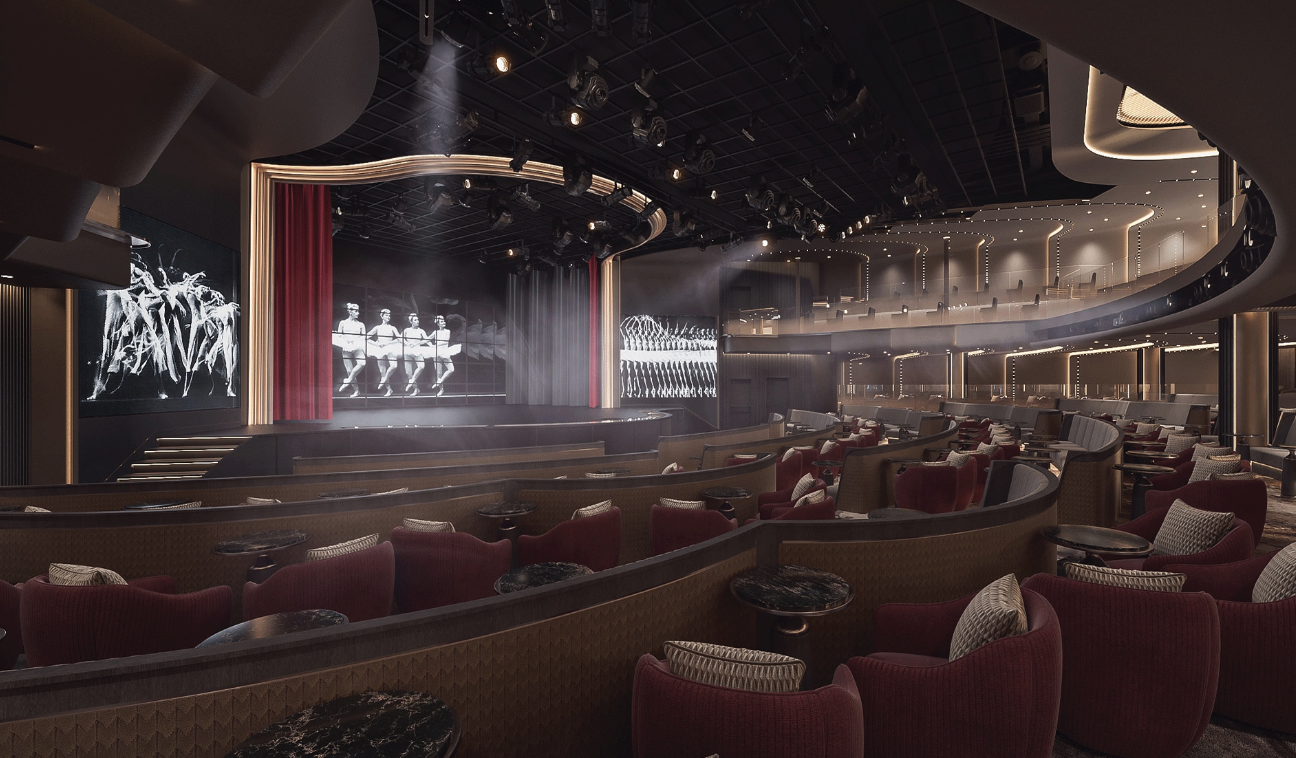
Thrill to nightly performances in our glorious, two-deck-high theater. Plush seating and pleasing sightlines free you to focus on our lavishly staged, high-energy shows produced by our own team of Broadway professionals.
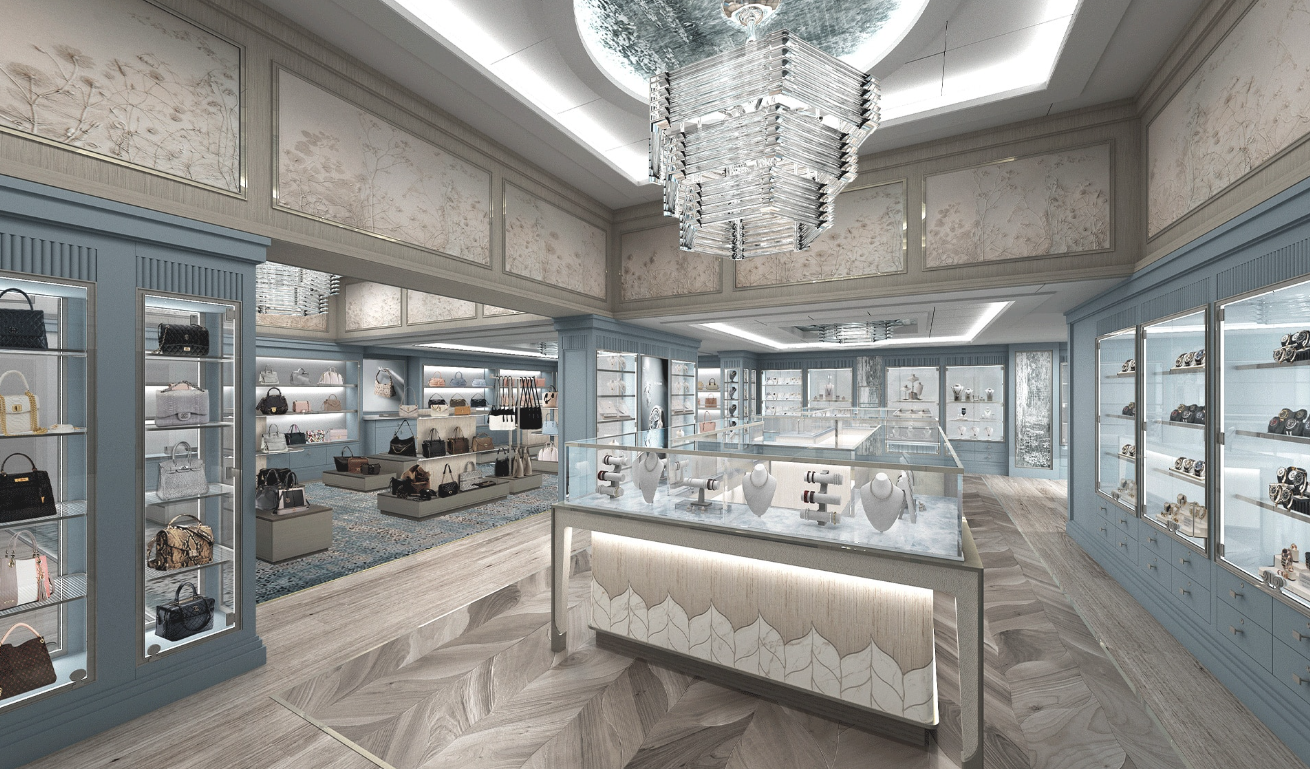
Browse designer garments, upscale handbags, exclusive fragrances and fine jewelry in an intimate and unhurried setting. A bit of shopping bliss, whether buying items for yourself or friends and family back home
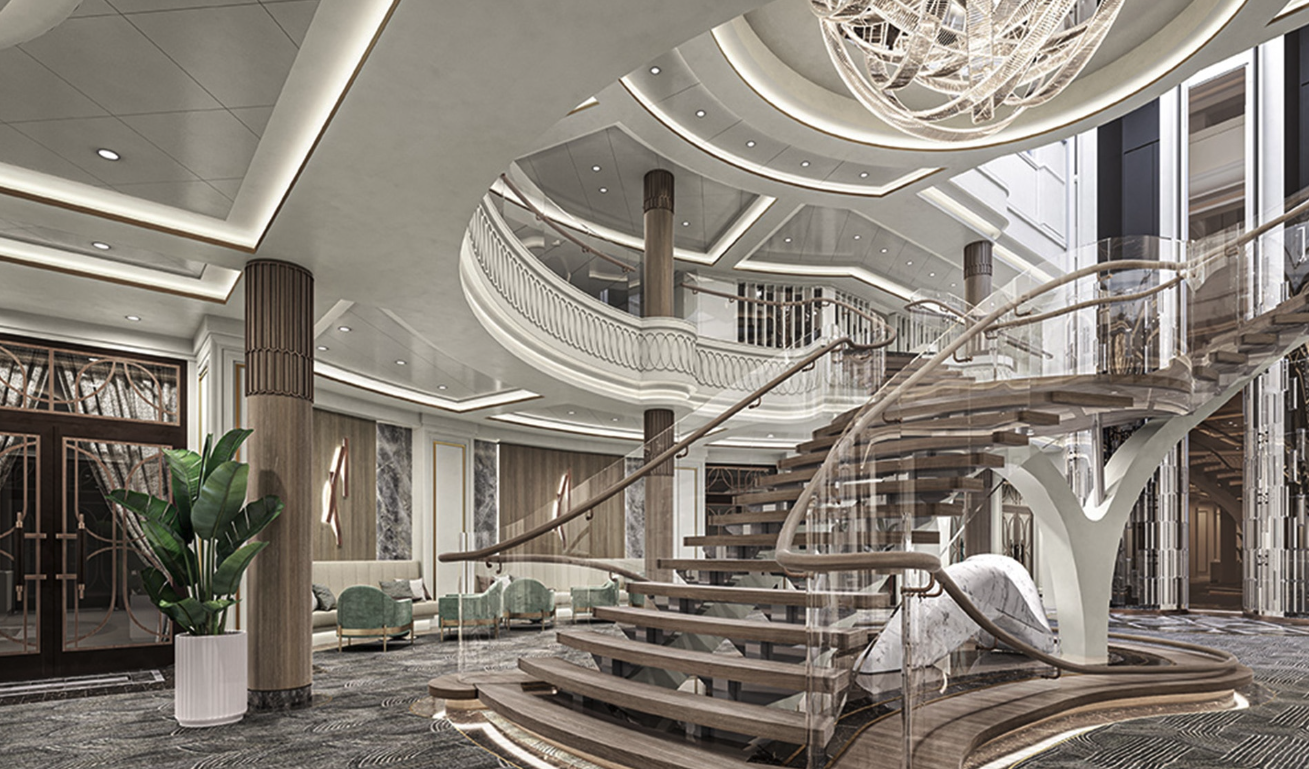
Simply put, the Atrium is the very heart of Seven Seas Grandeur™. With a magnificent chandelier above, the grand staircase descends to Compass Rose, our signature restaurant, creating a grand entrance.

Step into an intimate, sophisticated environment filled with fun and excitement. Challenge friends at the poker table, take on the house in a thrilling game of blackjack or sip a cocktail and watch the action unfold.

For those who’ve chosen to leave their laptops at home, desktop computers are available at our staffed Business Center. Of course, you may access WiFi without charge throughout the entirety of Seven Seas Grandeur™.
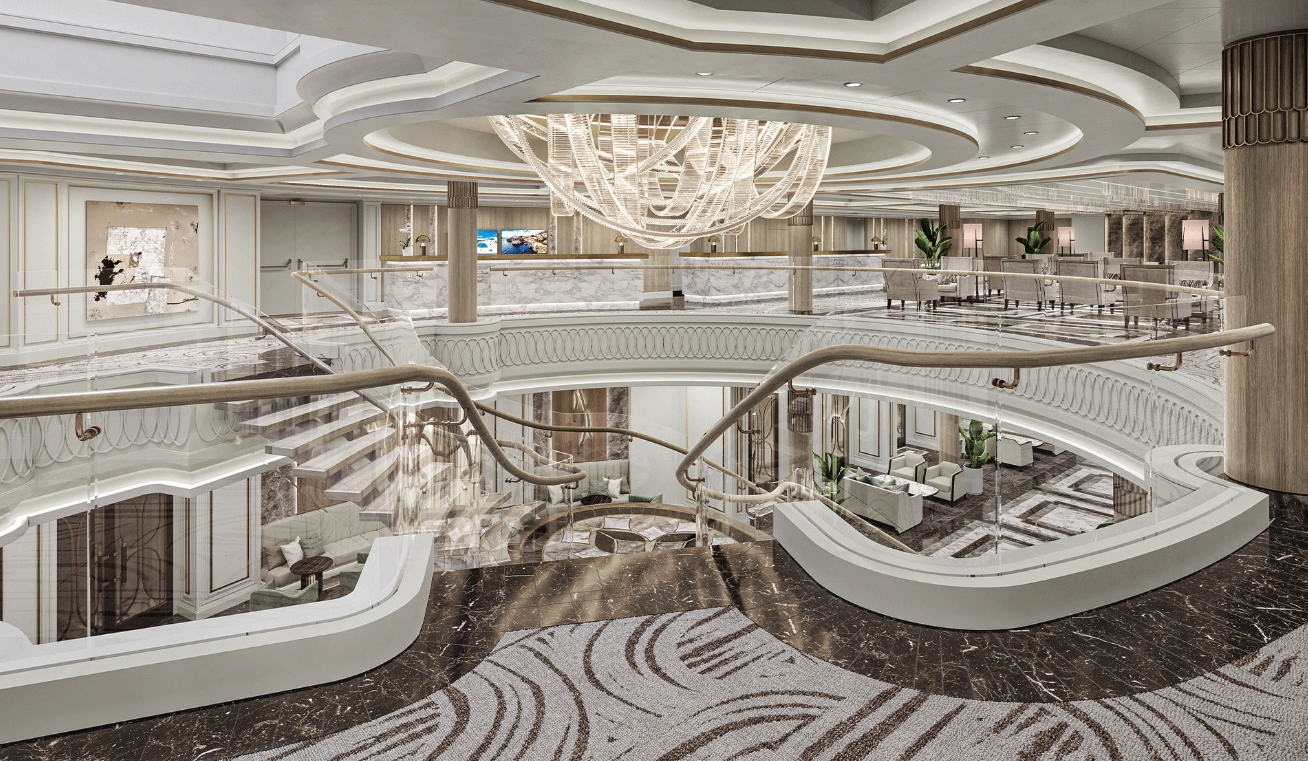
The place for you to arrange onshore activities, whether one of our FREE Unlimited Shore Excursions or a unique, small-group Regent Choice Shore Excursion. All staff are eager to provide the assistance you need.
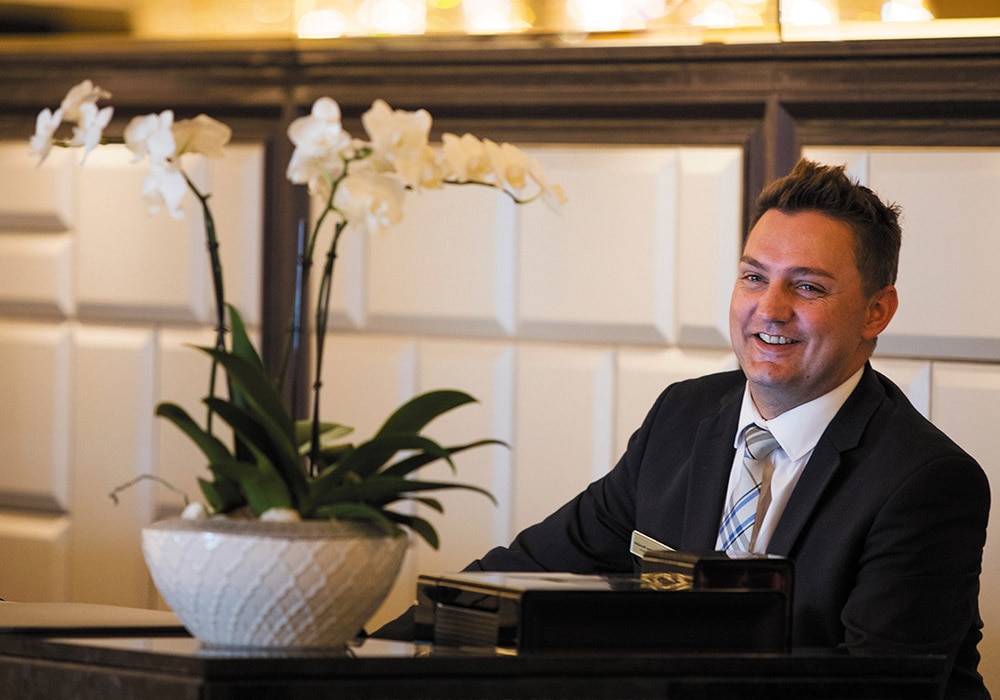
While cruise-related issues are first submitted to Reception/Concierge, you can be assured that a General Manager is on hand to resolve issues to your satisfaction.
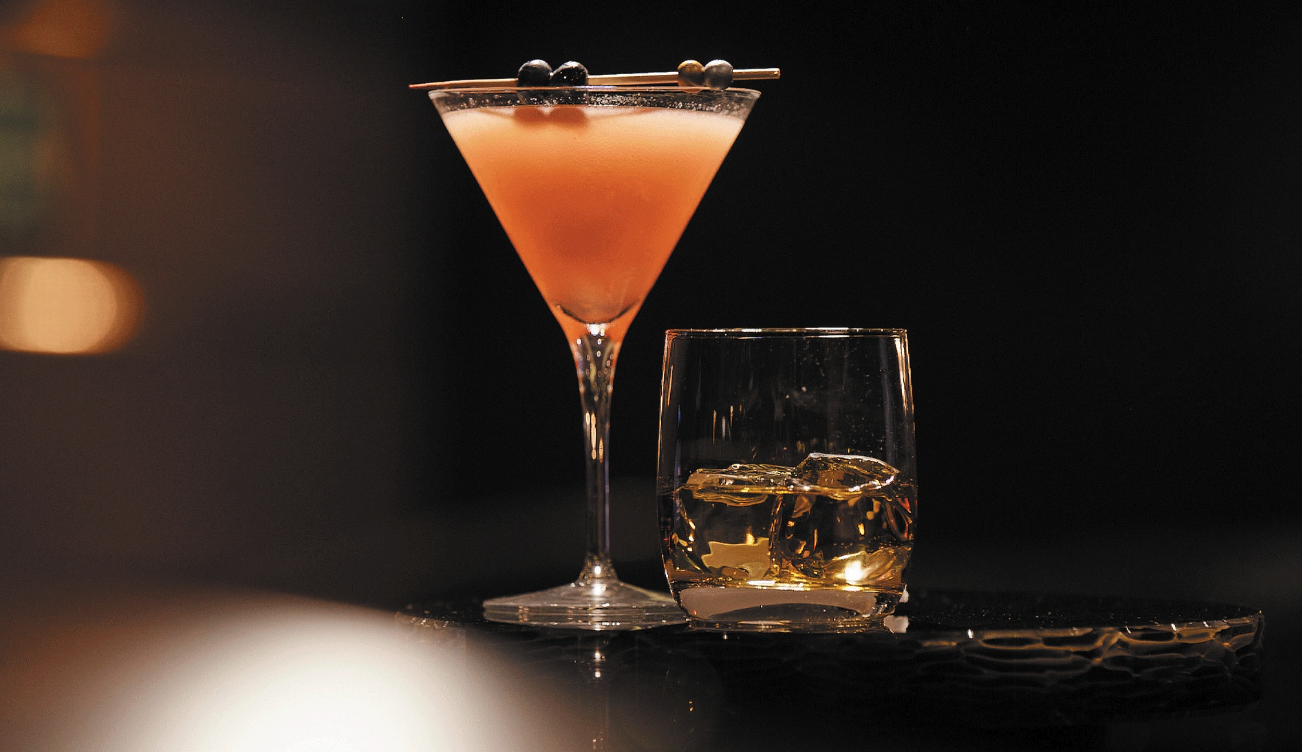
With an expansive bar and relaxed armchairs, this is an ideal spot to gather with new friends for a cocktail, especially after an exciting theatre performance that simply must be discussed at length.
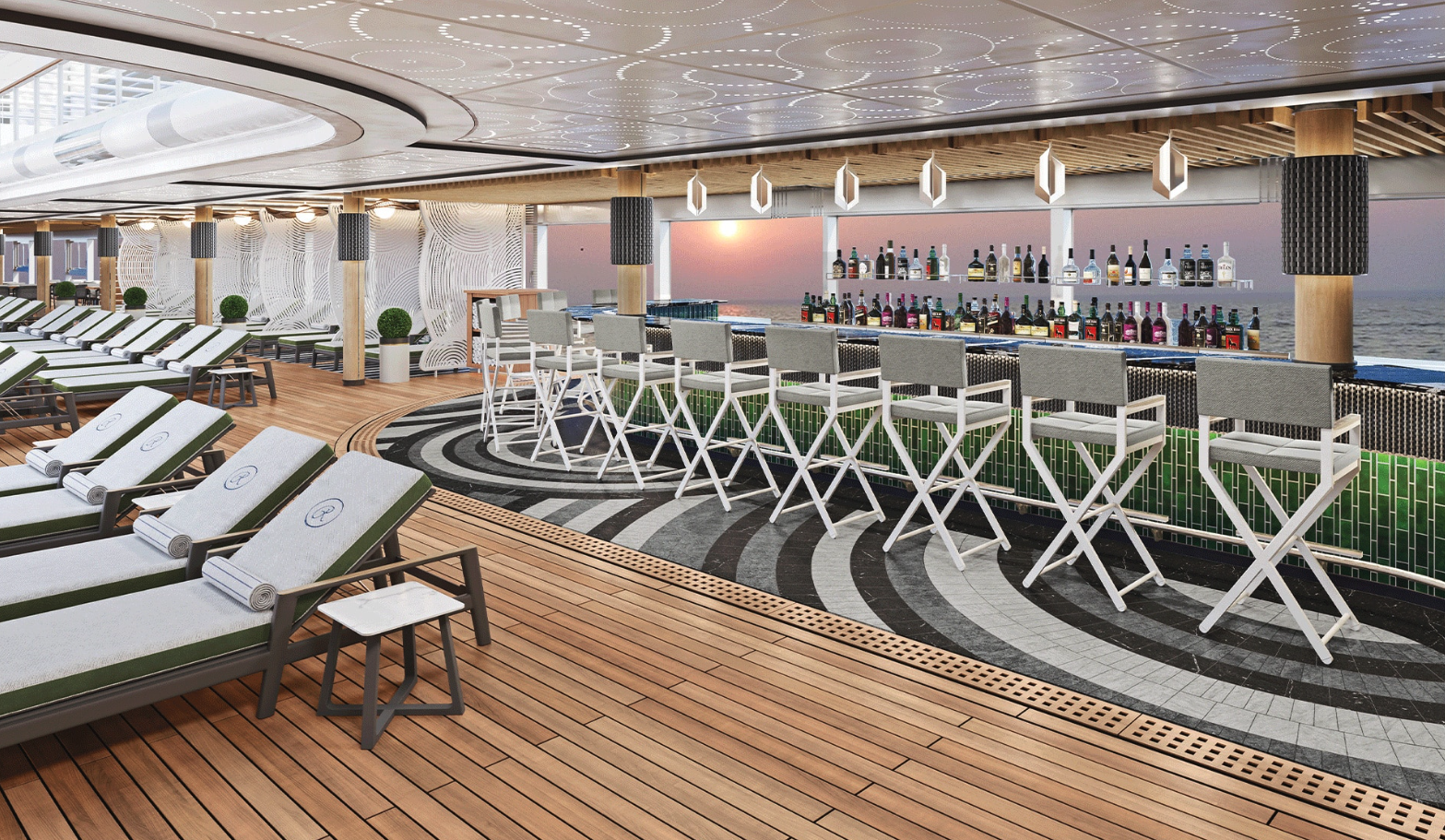
Very few things equate to a pure vacation activity more than sitting at our Pool Bar. Make new friends while sipping a cocktail or frozen drink in the most laid-back atmosphere imaginable.
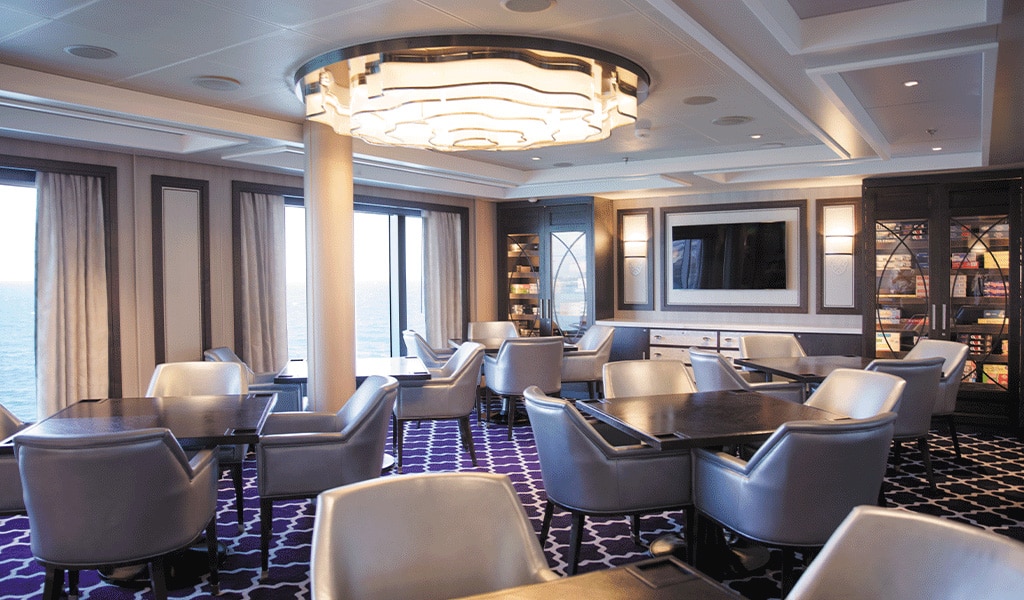
Seeking friendly competition? This jovial room has a clubby charm that’s both inviting and tranquil. Gather some friends for board games or Bridge, or maybe a tournament.

A very modern space with oversize leather armchairs and signature works of art, this guest favourite is more than its décor. You’ll immediately take to its low-key elegance, perhaps over a fine cigar and meaningful conversation.

Step into our welcoming and well-stocked library for a relaxing respite. Browse volumes ranging from destination-specific guidebooks to best-selling mysteries and classic literature.
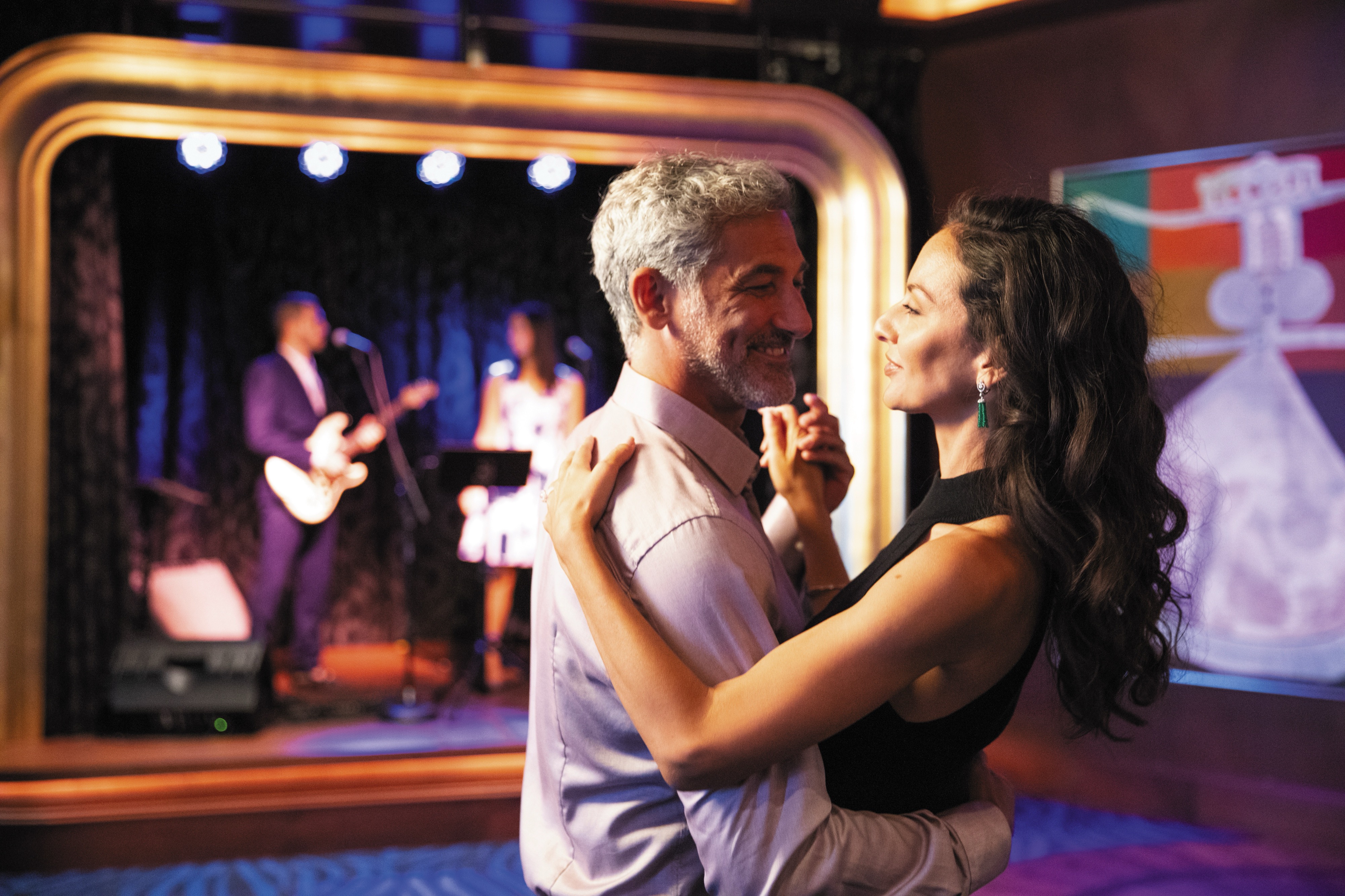
There’s no better way to whet your appetite for dinner than at this ship’s namesake lounge. Its elegant design will coax you into a state of relaxed bliss over signature cocktails and soulful sounds.
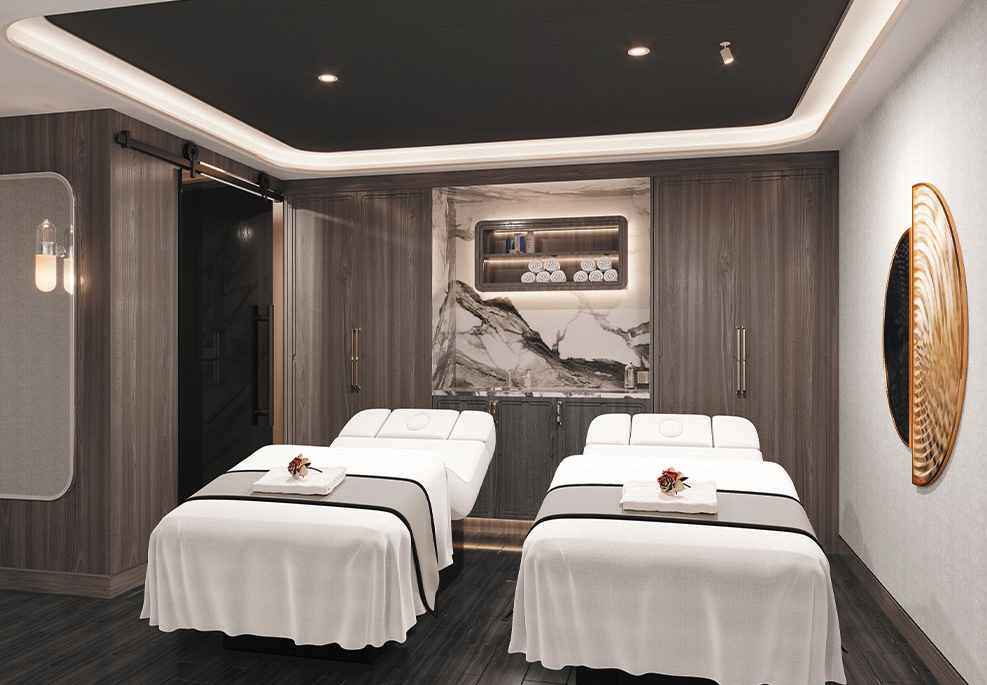
A globally inspired, tranquil haven of health, beauty and wellness, our spa offers restorative treatments and activities that incorporate globally sourced, natural ingredients to soothe both the body and mind.

Look after yourself at sea. Take part in Pilates, yoga and aerobics classes or help yourself to spinning bikes, dumbbells, treadmills, Technogym Strength Machines, workout mats and step benches. For guests 16 and over.
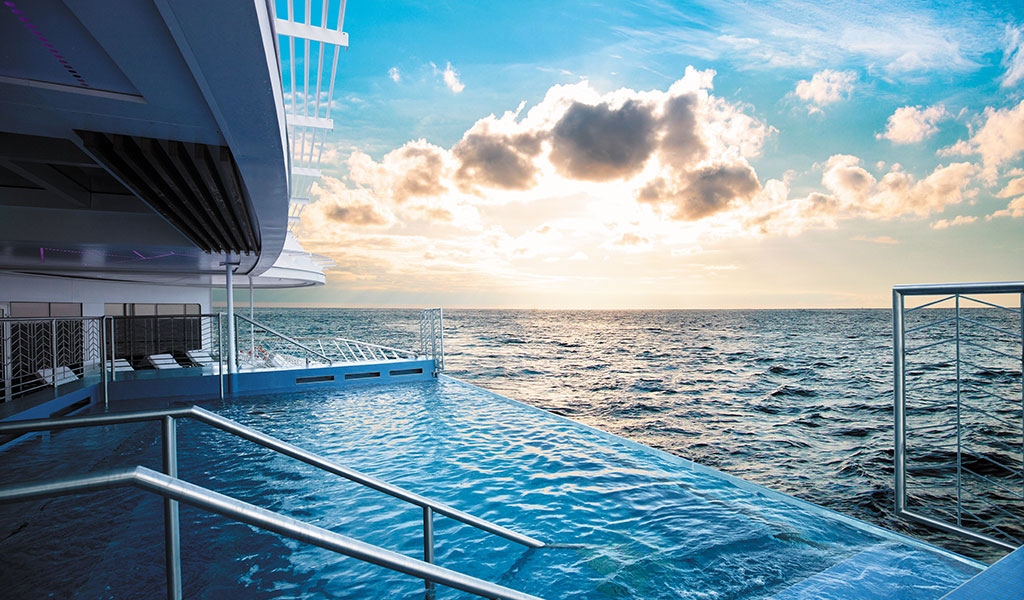
Go for a swim, stay for the views. Wherever you are in our Infinity-Edge Plunge Pool the views are dramatic, as the pool contours to the stern of the ship.

If you have a regular walking or running routine, fear not – your healthy habit can be maintained while cruising the high seas. Regardless of the speed you traverse our track, magnificent views await.

Practice your golf swing, go for a jog around the track, or gather some new friends for a spirited (but fun) game of bocce ball, all while taking in stunning views and fresh, ocean air.

If the mood strikes to work on your fairway swing, head to our Golf Net. All equipment is provided for you to practice your swing while soaking up the most glorious views imaginable.

Probably the game most associated with cruise ships, shuffleboard onboard Seven Seas Splendor™ is a more dramatic affair. High atop your ship, you won’t mind awaiting your turn as you take in glorious horizon views.

Gather some friends and engage in a game originated in 5,000 BC. Our Bocce Court has the requisite equipment – a pallina and 8 larger balls – for you to engage in a spirited contest as the sun sets.

Not nearly as serious as the Golf Net, our Putting Greens invite you to gather friends – perhaps after an afternoon cocktail – for a spirited round of putt-putt golf or two.

Our completely screened and well-maintained paddle tennis court will beckon you and your teammates to win at all costs – or simply enjoy a fun game of paddle tennis or two.
For details on a prearranged rental program, please contact our authorized vendor:
Scootaround Personal Transportation Solutions
Phone: 1.888.441.7575
Email: info@scootaround.com
scootaround.com/rent-online
Accessibility Options in suites 822 and 823. For more information about accessible suites click here.
Service or guide animals are allowed on board, provided the passenger notifies Carrier prior to the cruise of their intention to bring such animal and agrees to take sole responsibility for any expense, damage, injuries or losses associated with or caused by such animal.
Please advise Regent Seven Seas Cruises of any special dietary requirements you may have 120 days prior to sailing for voyages embarking in the US and 150 days for all other voyages, by sending an e-mail to specialrequests@rssc.com. General dietary needs such as low salt or low cholesterol foods can be satisfied onboard the ship just by speaking with the dining wait staff.
Infants must be six months of age as of the first day of the cruise. For voyages that have three or more consecutive days at sea, infants must be at least one year of age as of the first day of the cruise. Guests traveling with a young infant that does not meet the infant policy will be denied boarding. No refunds or other compensation shall be due from Regent Seven Seas Cruises to anyone as a result of the denial of boarding to an underage infant or any accompanying guests. Based on SOLAS requirements Regent Seven Seas Cruises cannot and will not make any exceptions to allow infants on any of their cruises which do not meet the minimum one year of age requirement. No waivers will be accepted. Please do not enquire about making any exceptions, as all requests will be denied. Any guest under the age of 18 must be accompanied by and occupy the same suite as an adult 18 years or older. Regent Seven Seas Cruises does not provide for the care, entertainment or supervision of children. Guests under the age of 16 are not permitted to use the spa or fitness facilities, even if supervised by an adult. Special promotional rates are available for children on select sailings. To be eligible, the child must be under the age of 18.
Attire ranges from Casual to Formal Optional. Casual wear consists of resort-style outfits; some examples are jeans, shorts, t-shirts, and tennis shoes. Casual wear is appropriate for daytime both on board or ashore. Casual wear is not appropriate after 6:00 PM. On the night prior to disembarkation, guests may need to pack their luggage early due to morning flights the next day. With this in mind, on the last night of every voyage, we will relax the dress code for dinner to Casual.
Otherwise, the recommended onboard dress in the evenings is Elegant Casual. Dinner dress for ladies includes a skirt, or slacks with a blouse or sweater, a pant suit or dress; slacks and a collared shirt for gentlemen. Sport jackets are optional. Casual wear is not to be worn at dinner. Ties are not required.
On sailings of 16 nights or more, Formal and Semi-Formal attire is optional on two of the evenings. On the two Formal Optional evenings, guests are welcome to dress as per the elegant Casual dress code or opt for a more formal choice of clothing including gowns and cocktail dresses for ladies; tuxedos, dinner jackets or dark suits with tie for gentlemen.
For the comfort and safety of all of our Guests, smoking is not permitted in any enclosed dining area, certain public venues, elevators, the Theater, and all suites and balconies, and is only permitted in specific designated smoking areas. The use of electronic cigarettes is allowed within designated smoking areas only.
Cigarette smoking is only permitted in designated areas of the outdoor pool area and the following public rooms:
- Seven Seas Splendor: Connoisseur Club, Pool area (designated area opposite side of the Pool Bar)
- Seven Seas Explorer: Connoisseur Club, Pool area (designated area opposite side of the Pool Bar)
- Seven Seas Voyager: Connoisseur Club, Horizon Lounge (outdoor one side designated area), Pool area (designated area opposite side of the Pool Bar)
- Seven Seas Mariner: Connoisseur Club, Horizon Lounge (outdoor one side designated area), Pool area (designated area opposite side of the Pool Bar)
- Seven Seas Navigator: Galileo’s (outdoor one side designated area), Pool area (designated area opposite side of the Pool Bar)
Cigar Smoking is only permitted in the Connoisseur Club on applicable ships and the designated area on the opposite side of the Pool Bar.
Pipe smoking is only permitted in the Connoisseur Club. Pipe smoking in open deck areas is considered an extreme fire hazard and is not permitted.
Failure to comply with the above smoking policy will result in guests being asked to leave the ship at their expense, without refund or credit for the unused portion of their cruise.
Our global sustainability program, Sail & Sustain, is centered around our commitment to drive a positive impact on society and the environment while delivering on our vision to be the vacation of choice for everyone around the world. We visit nearly 500 destinations globally, allowing our guests to travel and explore the world, and our business is inextricably linked to the preservation of our planet and the protection of our shared resources.
Our environmental, social and governance (ESG) strategy is focused on five pillars and was developed through cross-functional collaboration with key internal and external stakeholders. As we continue our ESG journey, we look forward to building upon this foundation and meaningfully contributing to the UN Sustainable Development Goals (SDGs) as we collectively chart a path towards a more sustainable future.
The sale and consumption of alcoholic beverages will be limited to guests aged 21 years or older. However, with the exception of Hawaii, Alaska and New England voyages not leaving U.S. territorial waters, guests between the ages of 18 through 20 may purchase and personally consume wine and beer only while on board and with the consent of an accompanying parent. Authorization will be given only when the accompanying parent completes the Young Adult Alcoholic Beverage Waiver form. This form can be obtained and completed at the Reception Desk upon embarkation. While sailing on select international voyages, guests 18 years or older are permitted to consume alcoholic beverages without having to complete the Young Adult Alcoholic Beverage Waiver form. Guests are kindly reminded to consume alcohol in moderation. Regent Seven Seas Cruises reserves the right to prohibit and retain all liquor brought aboard the ship.
Wireless access is available throughout the ship, including most suites. Access is provided utilizing satellite communication systems. Service and speed will vary port to port. Please be advised that bandwidth-heavy applications such as Skype, Netflix, YouTube and VPN are not included in our FREE Unlimited WiFi plans.
If you are utilizing a mobile device that access the internet via a cellular carrier’s network (4G for example) instead of the ship’s wireless access, it will be treated as if you were using your cell phone and International roaming charges will apply. Any costs associated will be billed directly through your cell phone provider, and not through the ship. Check www.wmsatsea.com for more information.
Each ship has a licensed and registered doctor and nurse for professional and emergency services, which are available at customary charges. The ships’ medical centers are designed to provide medical care for certain temporary illnesses and accidents, and are not intended or capable of providing on-going treatment of pre-existing medical conditions. For guests requiring oxygen equipment, an oxygen concentrator is the only form of oxygen equipment allowed aboard ship, and must be provided by the guest. Regent Seven Seas Cruises’ wheelchairs on board are for emergency purposes only.
All guests will now benefit from FREE Valet Laundry Service during their cruise. Enjoy the luxury and convenience of freshly washed, carefully pressed and folded laundry picked up and delivered to your suite throughout your voyage.
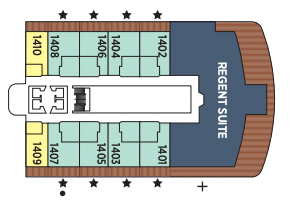
- Regent Suite
- Concierge Suite
- Penthouse Suite

- Putting Green
- Shuffleboard
- Golf Net
- Bocce Court
- Paddle Tennis Court
- Jogging Track
- Concierge Suite
- Penthouse Suite
- Grandeur Suite
- Grand Suite

- La Veranda / Sette Mari
- La Veranda
- Pool Grill
- Smoking Area
- Pool Bar
- Culinary Arts Kitchen
- Connoisseur Club
- Library
- Observation Lounge
- Pool

- The Study
- Chartreuse
- Prime 7
- Bridge
- Concierge Suite
- Superior Suite
- Penthouse Suite
- Grand Suite
- Grandeur Suite

- Master Suite
- Concierge Suite
- Penthouse Suite
- Grand Suite
- Grandeur Suite
- Superior Suite

- Launderette
- Penthouse Suite
- Seven Sea Suite
- Superior Suite
- Concierge Suite
- Master Suite

- Seven Seas Suite
- Penthouse Suite
- Superior Suite
- Concierge Suite
- Veranda Suite
- Grand Suite
- Deluxe Grand Suite

- Fitness Center
- Penthouse Suite
- Concierge Suite
- Deluxe Veranda Suite
- Veranda Suite

- Atrium
- Coffee Connection
- Constellation Theater
- Infinity-Edge Plunge Pool
- Meridian Lounge
- Pacific Rim
- Serene Spa & Wellness
- Business Center
- General Manager
- Destination Services
- Reception & Concierge

- Constellation Theater
- Boutique
- Atrium
- Grandeur Lounge
- The Casino
- Compass Rose

